
- Popular Posts
- How to Own a Horse Guides
- Latest Posts

How To Own a Horse
How far can you travel on horseback in one day.
- March 25, 2024
- Posted by Clare Dean
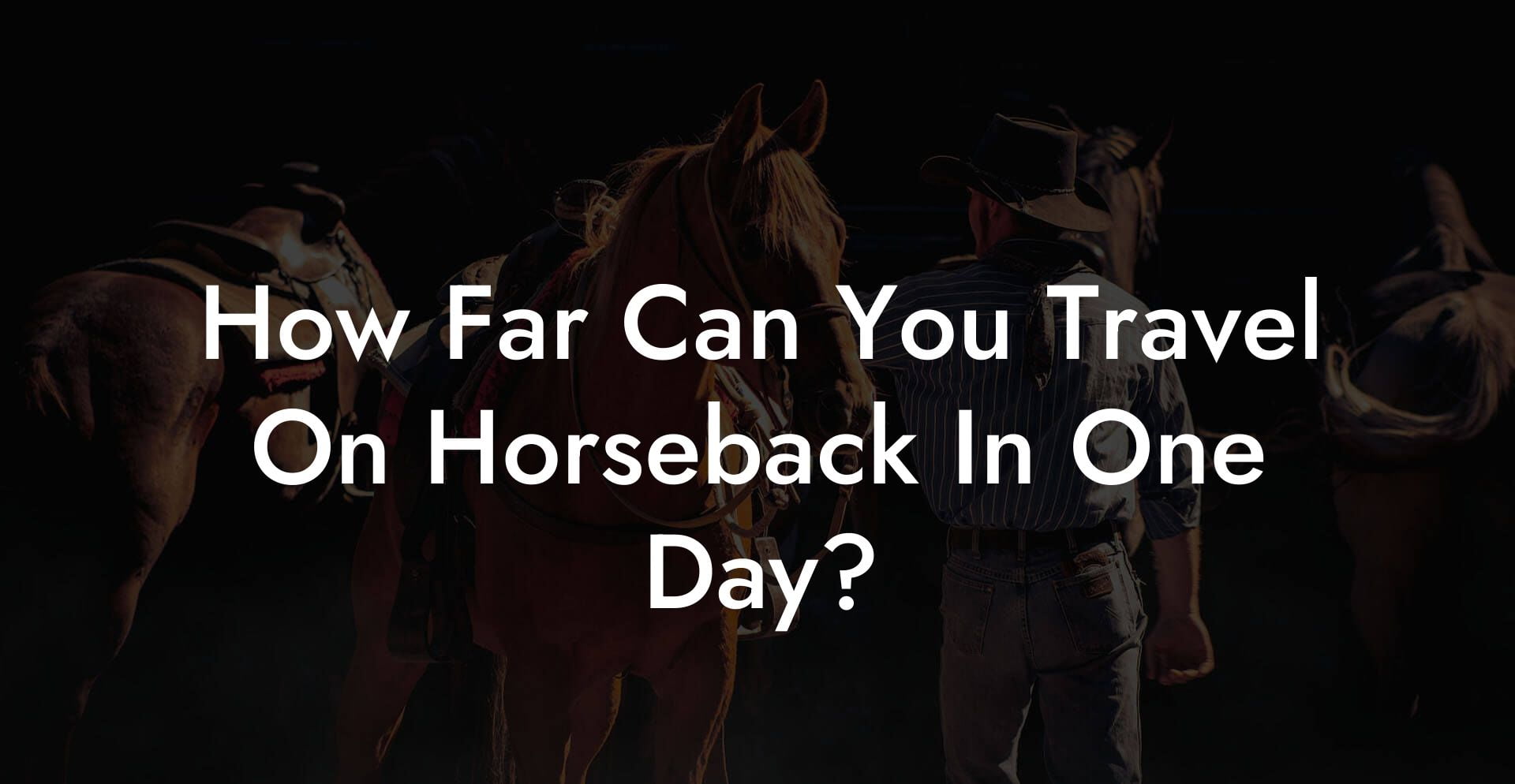
Horseback riding is a much-loved activity worldwide, whether it's for leisure, transportation, or competitive sports. As horse owners and riders, we often find ourselves wondering about the distance our horses can comfortably cover in a single day. The answer to this question is not as straightforward as it might seem, as many factors come into play, such as the horse's fitness level, terrain, weather conditions, and of course, the rider's skills and experience. In this blog post, we'll delve into these factors and provide a realistic estimation of how far you can expect to travel on horseback in one day.
How Far Can You Travel On Horseback In One Day Table of Contents
Picture this - you've planned an exciting trail ride that stretches over days or perhaps even weeks. As you ready yourself and your horse for the adventure, you might be left wondering how many miles you can realistically cover in a day. This question might seem simple on the surface, but many different factors can impact this number. Read on as we explore these factors and help you determine how far you can travel on horseback in one day.
1. Horse's Fitness Level
Various breeds have different endurance levels and physical capabilities. For instance, Thoroughbreds, Arabian, and quarter horses are typically more agile and faster than draft horses. Nevertheless, each horse is an individual, and its fitness level will play a crucial role in determining how far it can go.
Like humans, horses need consistent conditioning to increase their endurance. A well-conditioned horse, regardless of its breed, will usually be able to cover more ground than an out-of-shape one. Gradually increasing ride distances and incorporating interval training can significantly improve a horse's stamina.
Not all landscapes are created equal when it comes to horseback riding. The terrain has a considerable impact on how far a horse can travel in one day. A flat, even surface, such as a well-trodden path or a graded dirt road, allows for more comfortable and faster-paced riding. In contrast, rugged terrain with steep inclines, rocky surfaces, or heavy undergrowth can slow you down and require additional effort from both horse and rider.
3. Weather Conditions
Extreme weather conditions can also affect the distance a horse can cover in a day. High temperatures and humidity can cause dehydration and heat exhaustion for both riders and horses, leading to a slowdown in pace and even potential health risks. On the other hand, cold weather riding presents its challenges, such as slippery surfaces and reduced visibility. Proper hydration, nutrition, and acclimatization are necessary to maintain the well-being of both horse and rider during long distance rides.
4. Rider's Skills and Experience
A rider's skill level and horsemanship also play a role in the distance covered in a day. An experienced rider will know how to effectively pace the horse, manage its energy levels, and recognize signs of fatigue. Additionally, they'll be able to navigate challenging terrain more efficiently, potentially covering more ground in a day.
How Far Can You Travel On Horseback In One Day? Example and Results
With all the variables taken into account, it's essential to keep in mind that each horse and rider combination is unique. However, an average, well-conditioned horse, with a skilled rider, can comfortably cover 20-30 miles in a day on flat terrain at a steady walk or trot. This number can vary if factors such as difficult terrain, adverse weather conditions, or health issues arise.
Keep in mind that marathon and endurance races cater to the extremes, with some horses and riders covering 50 to 100 miles in a day under intense conditioning and training. But these extreme distances place significant physical and mental stress on both the horse and rider and are not meant for casual trail riding.
In conclusion, it's crucial to consider your horse's fitness level, the terrain, weather, and your skills as a rider when planning a long-distance ride. By understanding and managing these factors, you can ensure a safe, enjoyable, and fulfilling journey for both you and your horse.
We hope you found this article informative and engaging! Please feel free to share it with fellow horse enthusiasts, and be sure to explore the array of other guides and resources available on How to Own a Horse for all your horsey needs.
Related Posts

Horse Care UK
- April 23, 2024
Continue reading

Easy Horse Care

Do Horses Need Hay If They Have Grass

Horse Care Supplies

Horse Care Tips And Tricks

Horse Care For Beginners
- April 22, 2024

Horse Care Near Me

Horse Care Heat

Horse Care Courses

Using a Leaf Blower to Clear a Stable

World's Best Horse Rider

Horse Care Guidelines

How Far Can Horses Travel in a Day? (5 Things to Consider)
I don’t have as much time now, but I remember when I was younger I loved going on day-long trail rides with my horse. At the end of the day, I would wonder: how far did we go? How far can you travel by horseback in a day?
In this article, I’m going to answer all of your questions about how far a typical horse can travel in a day so you can plan your adventures accordingly!
If you’re interested in improving your riding skills on your trail rides (keeping pace, steering, having an emergency brake you can use if your horse bolts), check out my 100% FREE Beginner Rider’s Ebook: Click here to learn more!
How Many Miles Can a Horse Travel in a Day?
The short answer to the question is: it depends! Here are the factors to consider:
- The horse’s pace
- The terrain and footing you’re riding on
- The weather conditions
- Your horse’s fitness and physical ability
- Your ability as a rider
Knowing how far can you travel by horse in a day is essential if you plan on going on a fun trail adventure together, so let’s dive deeper into each of these considerations.
P.S. If you’re planning a long trip and need to get a saddle bag, check out our recommendations here!

The Pace of the Horse’s Travel
Understanding at what pace your horse moves will help in determining the amount of distance you cover and the time it takes to travel a certain distance in one day.
Generally, horses walk at an average speed per mile. A number of factors come into play when you go on a day-long journey with your trusty steed.
How Fast Are Horses?
A horse can go up to four miles per hour when it walks and typically travels somewhere between eight and 12 miles per hour at a trot.
At a canter, a fit horse can speed up anywhere between 12 and 15 miles per hour. At a gallop, they can travel between 25 and 30 miles per hour on average. Of course, a gallop can’t be sustained for very long and it’s unlikely the terrain will allow for a long gallop either.
Let’s Do The Math: On Average, How Long Can You Ride a Horse in a Day?
Typically, a healthy horse will comfortably walk for about eight hours.
By using the data above, that would mean that you could possibly cover about 32 miles . However, not many riders (especially those who aren’t used to riding long distances) can sit in the saddle for eight hours straight without getting very uncomfortable. If I tried to do that these days, I’d be so sore!
If you’re riding a more fit trained horse, it can occasionally trot or canter too, which can reduce the amount of time taken to cover certain mileage.
Existing Terrain and Footing
The estimated time and distance that we have given above is based on a healthy horse’s pace, riding without any form of interruption. But the second thing to consider when deciding how far an average horse will be able to travel is the terrain.
One reason that your horse could slow down or speed up depends on whether or not the riding conditions are favorable.
The terrain you travel on plays an important role in determining the distance you travel in a day. If your horse is not familiar or not comfortable with the terrain, your horse will tend to slow down to ensure safe footing and your travel time will be slower than expected.
When I went riding in Colorado, even though we were riding trained horses that were very comfortable with the steep hills and rocky passages, the horses still had to slow down in order to safely navigate the terrain.
Similarly, when we went for long rides in Arizona, we could canter and gallop across the flat plains, but then when we took trips up to the steep hills, we would travel much slower.
Navigating your horse through grounds that have steep hills means there is more stress on the horse’s limbs and cardiovascular system in comparison to when it travels on even ground.
If the terrain on which you’re traveling is hard and bumpy with lots of rocks, the impact on your horse’s hooves and joints will likely be more pronounced. If this happens, your pace will automatically go down in order to save your horse from any injury.
Additionally, traveling in areas that have sand or deep mud could also be a challenge for your horse.
Your horses’s tendons and ligaments would have to withstand more stress and exert more force to keep you moving.
In determining how far you can ride a horse in a day, you must always consider your riding path. The more stressful the terrain is, the slower your horse’s pace will be.

Weather Conditions
Always make sure you take weather conditions into consideration when planning your ride, too. If you haven’t ridden in poor weather before, you might not realize the extent to which weather can play a critical part when you are planning horseback rides, especially if you plan to ride the whole day.
Extreme weather can bring discomfort and, in worse cases, severe injuries or illness to your horse if they were to stumble, trip, or get too cold/hot.
Riding under the scorching heat of the sun is likely to affect your travel time, maybe even by a lot. When horses sweat, they tend to lose a large amount of water and electrolytes. That means if a horse gets dehydrated or runs severely low on electrolytes when you are traveling, the horse can suffer from health consequences that could be severe in nature.
Conversely, if your horse is subjected to extremely cold and windy weather without proper protective gear, they may not be eager to move. Cold weather can cause stiffening of muscles. The frozen ground can be stressful on hooves and joints. It can also worsen any underlying or old injuries.
If you do choose to take your horse on long periods of riding in bad weather, you may need to take frequent stops from riding in order to prevent serious injuries. This will in turn affect your potential travel time.
The Overall Fitness of Your Horse
Things like your horse’s breed and age can also affect how far they’re able to travel. Regular training and exercise will keep your horse healthy and fit. But some other factors can affect your horse’s overall fitness are out of your control.
It goes without saying that older horses may have a higher chance of having health issues such as arthritis. Aging horses may not be able to keep up with the speed you expect.
You should also consider any previous or current injuries and how they might affect your horse.
That said, you might be able to offset some fitness concerns by doing a few simple things:
- Ensure that you keep your pace reasonable so your horse does not get tired quickly.
- Make frequent stops to prevent exhaustion.
- Provide necessary riding equipment (this also includes food and water) for your horse to protect them during your journey.

I should also say that especially if you are planning a multi-day ride, it’s a good idea to take your horse to the vet (particularly if you haven’t been in a while). To know how far you can ride, you have to know exactly how fit your horse is. Your vet should be able to provide some insight on that and give you any recommendations or warnings.
Rider’s Fitness & Skill Level
Lastly, to go the distance, you must also make sure you are physically fit and capable as a rider. It’s not just the horse that needs to be skilled… If you’re not able to guide your horse over a puddle they find a little scary, you could be stuck in the same spot for a while!
You should train and exercise to build up your health and fitness . Make sure you are physically fit and well-rested. Having good focus and a clear mind will also help you get through your long journey ahead.
It is not wise for you to go straight to a whole day of horseback riding without trying a few easier trails first. Prior to your long adventure, try to do a few shorter trails. These shorter rides will help you get ready for longer ones.
You might be surprised how quickly you get saddle sore after half a day of riding or so, especially if you’re doing a fair amount of trotting!
Posts on Fitness & Flexibility For Riders You Might Like
For more guides on how to train as a rider, check out these articles:
- Ankle Mobilization Exercise & How To Keep Your Heels Down
- Complete Guide to Exercise for Riders
Posts on How to Improve Your Skill Level
- 10 Tips To Look Like A Pro On Your First Ride
- 10 Western Horseback Riding Tips for Beginners
- How to Move A Horse Forward Under Saddle
- How to Slow Down A Hot Horse
- The Secret Walk-to-Trot Riding Aid
- How to Sit the Trot
- How to Establish Neck Flexion
- How to Collect a Horse
- How to Ride Without Stirrups
- How to Stop a Bolting Horse
- How to Ask for the Canter
- How to Master Jumping While Minimizing Fall Risk
If you enjoyed this post, you might enjoy my FREE Beginner Rider’s EBook ! You’ll learn how to keep a consistent pace (whether you’re riding a fast or slow horse), how to make smoothened transitions, how to finally get the flexion and bend you want, The Emergency Brake as well as bonus chapters on making cantering and jumping so much easier!
Conclusion: How Far Can a Typical Horse Travel in a Day?
As you can see, determining the distance of how far your horse can travel in one single day is quite difficult.
There are a lot of factors to consider when determining how far you can travel by horseback in a day. To ensure that you travel as far as possible, make sure you get out on some practice rides to get you and your horse in shape!

There are so many physical and mental health benefits to trail riding, and it can be a great way to get out into nature and see the world. So get out there and enjoy it!
Happy riding!

1 thought on “How Far Can Horses Travel in a Day? (5 Things to Consider)”
Yes, that’s right. I would also recommend starting with short distances, even if you are confident in your horse and she is super athletic.
Leave a Comment Cancel reply
This site uses Akismet to reduce spam. Learn how your comment data is processed .
Terms and Conditions - Privacy Policy
- About Horse Rookie
- Work With Us
- Write For Us
Equine Odometers: How Far Can Horses Travel in a Day?
As an Amazon Associate, I earn from qualifying purchases. Please read our disclosure for more info.
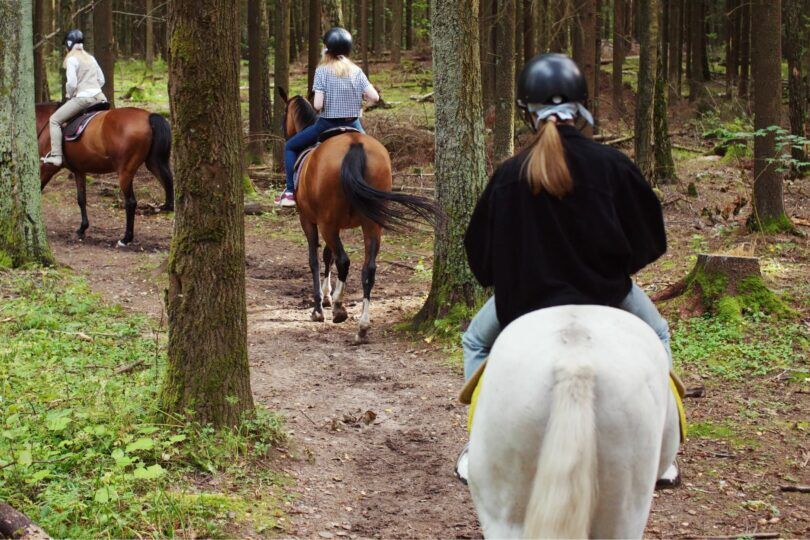
Mile Markers & Hoofprints
Horses were built more for distance than speed , although top racehorses have clocked speeds of up to 55 mph. But how far can (and should) a horse be asked to move in a single day?
Horses can travel anywhere from 10 to 100 miles in a day, depending on their age, breed, health, and level of fitness. The average horse can travel 25-40 miles in a day, whereas endurance horses can travel up to 100 miles a day for up to three days.
It’s important to take the time to get your horse in shape before attempting any longer or endurance rides.
Source: Canva
Equine Range
There’s a wide range of horse breeds in the world, and each excels at different things. Some horses could travel 10-20 miles in a day, others can travel up to 100 miles in a day.
The individual horse’s range depends on their age, breed, and level of fitness.
Horses in the Wild
Wild horses can cover 20-40 miles in a day in order to forage for sufficient food and water. They could potentially travel farther, but a lot of their traveling involves grazing, which slows them down.
The Importance of Fitness & Conditioning
It’s of paramount importance to take the time to get your horse in shape before attempting any long or arduous travel. It can take six to eight weeks to develop a basic level of fitness and years to get a horse in endurance-level shape.
Endurance-level shape equates to traveling up to 100 miles in one day
Equine Gaits and Their Speeds
The endurance horse.
Endurance horses are some of the fittest horses around. They can travel 50-100 miles a day in peak condition for up to three days (before needing a day or two to rest).
The Working Ranch Horse
Working ranch horses are powerhouses in their own rights, covering 20-25 miles each day with minimal strain.
The Carriage Horse
Carriage horses are sturdy and strong, capable of traveling 10-30 miles in a day.
How Far Can a Horse Travel…
Frequently asked questions, q: how far can a human travel in a day.
A healthy, fit human could travel 20-30 miles in a day.
Q: How far did cowboys travel on horseback?
On flat land, cowboys might cover anywhere from 30-40 miles in a day’s work. On hilly terrain, this distance may be reduced to 20-30 miles. If you were to transition to mountainous geographies, the average daily range reduces farther to 15-20 miles.
Q: How long does it take a horse to travel 100 miles?
The average, healthy horse can cover between 25 and 35 miles in a day, so it would take three to four days. A highly trained endurance horse could do 100 miles in a single day.
Q: How far can a horse travel without stopping?
If the horse is in great shape, he could reasonably cover 20-40 miles without stopping. Breaks are highly recommended, however, to allow for hydration and to prevent injury.
Q: How far can a horse travel in 3 hours?
Depending on his level of fitness and speed (walk, trot, canter, or gallop), a horse could travel anywhere from 12 to 30 miles.
Q: How far can a horse carriage travel in a day?
A carriage horse can travel between 10-30 miles in a day, depending on the horse, carriage weight, terrain, and weather.
Q: How long would it take to travel 1000 miles on horseback?
Depending on the horse and the terrain, it would take anywhere from 10 to 60 days to travel 1,000 miles.
Q: How far can a horse run with a rider?
Most in-shape horses could only gallop for a mile or two at a time or canter for five to seven miles at a time. A horse can carry a rider at a slower gait (like a walk or trot) for much longer.
Parting Thought
Whether you’re planning a horse-friendly camping trip or are considering trying your hand at an endurance event , rest assured your horse, with the right training, is more than capable of going the distance.
P.S. Enjoy this article? Trot on over to:
- Friendly & Fun: 4 Best Horse Breeds for Beginners
- How Much Horses Cost & How You Can Afford One
- 13 Best Boots for Horseback Riding Lessons
- 60 Questions to Ask When Buying the Horse of Your Dreams
- Horseback Riding: What to Wear (With Pictures)
- 8 Best Horse Riding Helmets for Hot Weather
- Horseback Riding Safety Equipment That’s Worth Every Penny
You may also like
Inside the equine mind: pursuing psychology, speaking their language: translating horse physiology..., love & let go: saying goodbye to your heart horse, safe vs. scared mindset, horse boarding basics (etiquette *everyone* should..., barefoot horses 101: why you *may* want to go barefoot, about the author, annakah stadlwieser.
Owner and equine photographer of Reversed Eye Photography, Annakah serves the the Edmonton, Canada area. She is happiest with her horse, behind a camera, or wandering in the forest. More than anything, she loves meeting horses and the people who love them and getting the chance to tell their stories through photographs!
How Far Can a Horse Travel In a Day? (8 Facts)
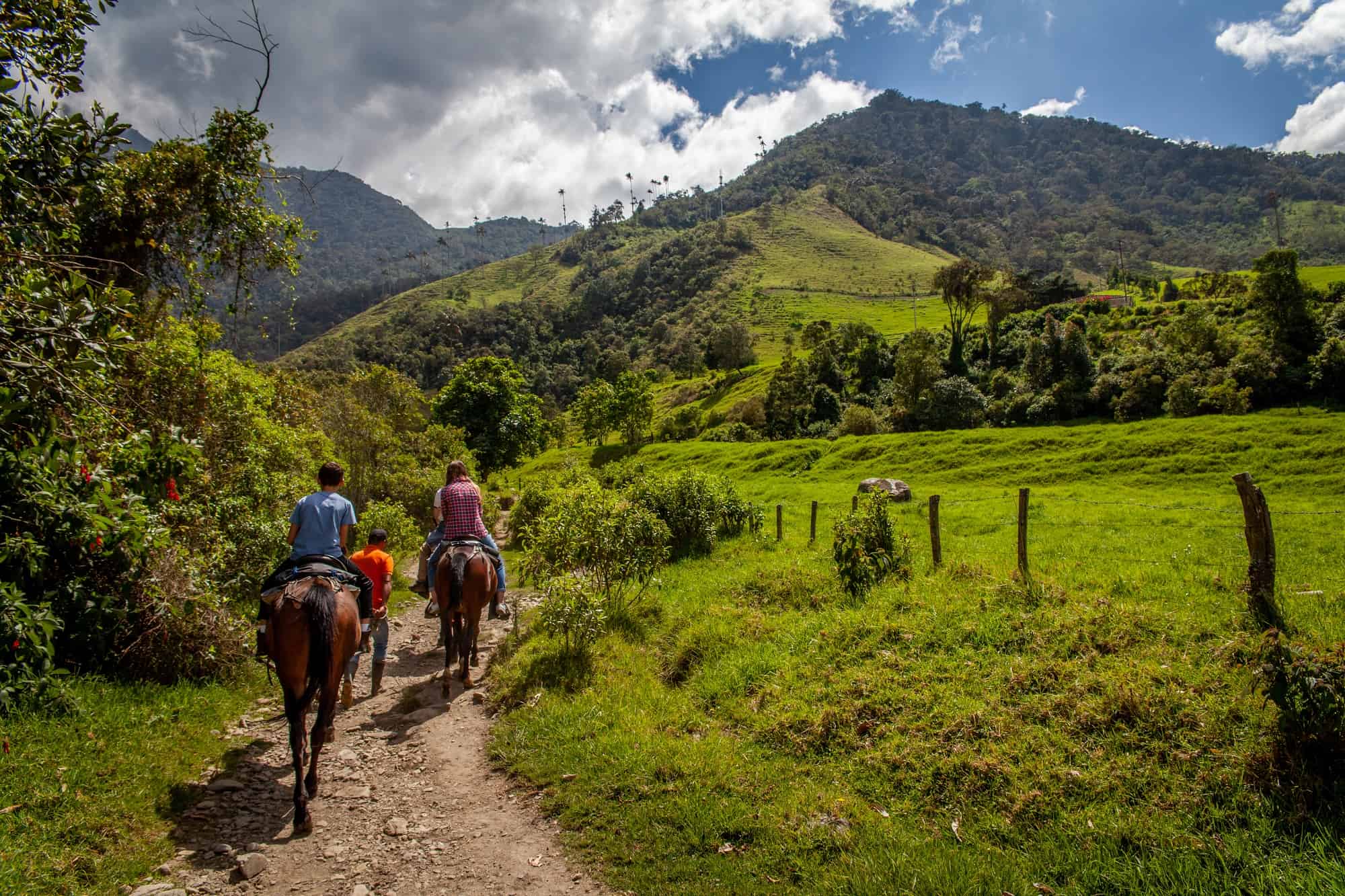
As no two horses are the same on the planet, there is no single answer to how far a horse can travel in a day. First, you should know that a horse moves its legs in three different ways, from the slowest gait, faster trot, and the fastest gallop.
Second, many different factors affect how much a horse can cross during the day, including the horse’s breed and age. However, its speed will also depend on the load it carries, terrain configuration, and weather conditions. Let’s take a closer look.
Today’s Horses vs. Horses in the Past
Always keep in mind that people use horses differently these days than hundreds of years ago. It is unnecessary to rely on these animals for long daily journeys, so they have adjusted to the new circumstances.
Unlike horses trained to complete everyday journeys in the past, modern ones are less capable of doing the same, with rare exceptions. While horses traveled about 35 miles (56.5 km) daily in those times, most of them can travel only 25 miles (40 km) a day nowadays.
How Far Can a Horse Travel In a Day
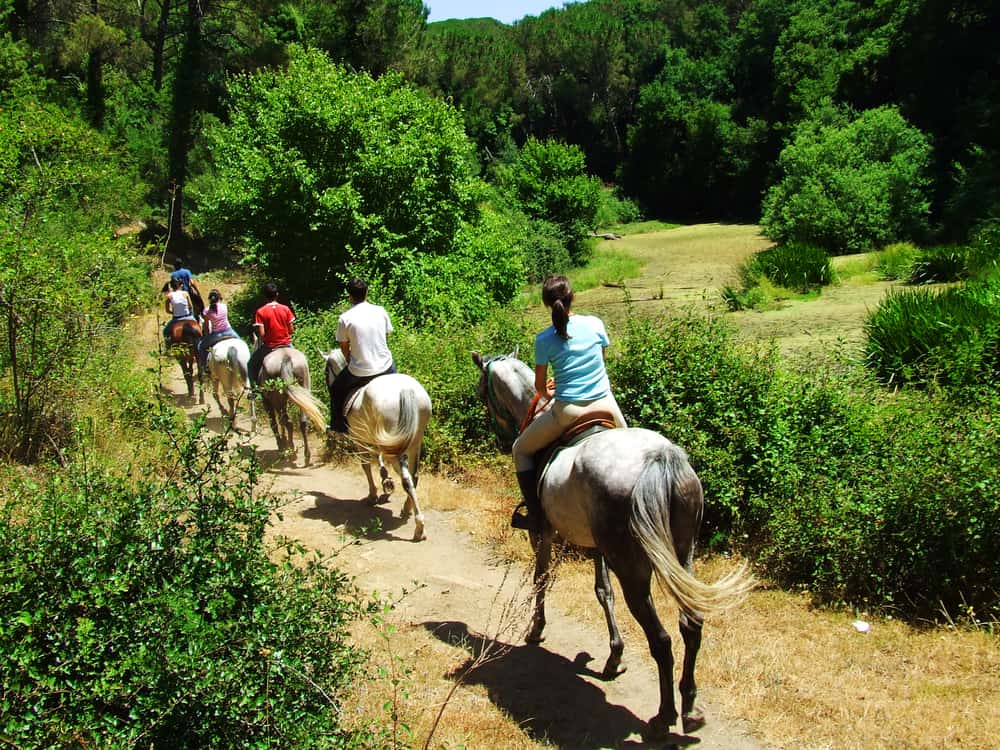
There are a few crucial factors that will affect your upcoming long journey. The primary things you need to take care of are your and your horse’s fitness and skills.
You both need to be rested, well-fed, and with an adequate amount of water supplies. Additionally, you should check your equipment, terrain, and weather conditions. Let’s take a look.
The mileage that a horse can cover in one day largely depends on horse movement types. The gait pattern depends on the horse you have.
Some naturally have efficient movements so that they can travel faster and further with less energy burning. Plus, they are more comfortable for the rider. You can recognize two gait types, including:
Natural gait
It includes walking, trotting, and running.
- Natural walk – A simple natural walk means a four-beat gait and covers up to 4 mph (6.5 km/h).
- Trotting – While trotting, a horse can move a two-beat gait at a speed of about 8 mph (13.9 km/h).
Ambling gait
It is a combination of natural and learned movements, such as cantering and galloping.
- Canter (lop) – It is a 3-beat gait that allows a horse to cover 10 to 17 mph (4.5 – 7.5 km/h).
- Gallop – It can be both natural and ambling gait type and means that a horse covers approximately 30 mph (48.5 km/h).
Horses can walk or gallop at a certain pace and an average speed per mile. It can vary depending on the horse type, rider skills, terrain, and weather conditions.
As I have already mentioned, a typical horse can walk at a speed of approximately 4 mph (6.5 km/h), trot at about 8 and 12 mph (13.9 – 19.5 km/h), while it can reach at least 25 and 30 mph (40 – 48 km/h) when galloping.
Never believe the famous scenes from movies. Most average horses can travel at the pace of a gallop only 2 miles (3 km) without fatigue and about 20 miles (32 km) at the pace of a trot. You can ride your horse 25 and 35 miles (40 – 56.5 km) without rest when it walks steady.
An average trail horse in decent shape can withstand a journey of 50 miles (80.5 km) in one day, while a fit endurance competitor will be able to travel even 100 miles (161 km) in a day. On the other hand, most of them can’t endure a few consecutive days of riding without a day or two of rest.
A more fit animal can cover more distance when trotting and cantering one part of the way. Be aware that there are no many riders who can sustain that pace. On the other hand, some horses can’t ride for eight hours in one day.
Horse’s health and fitness
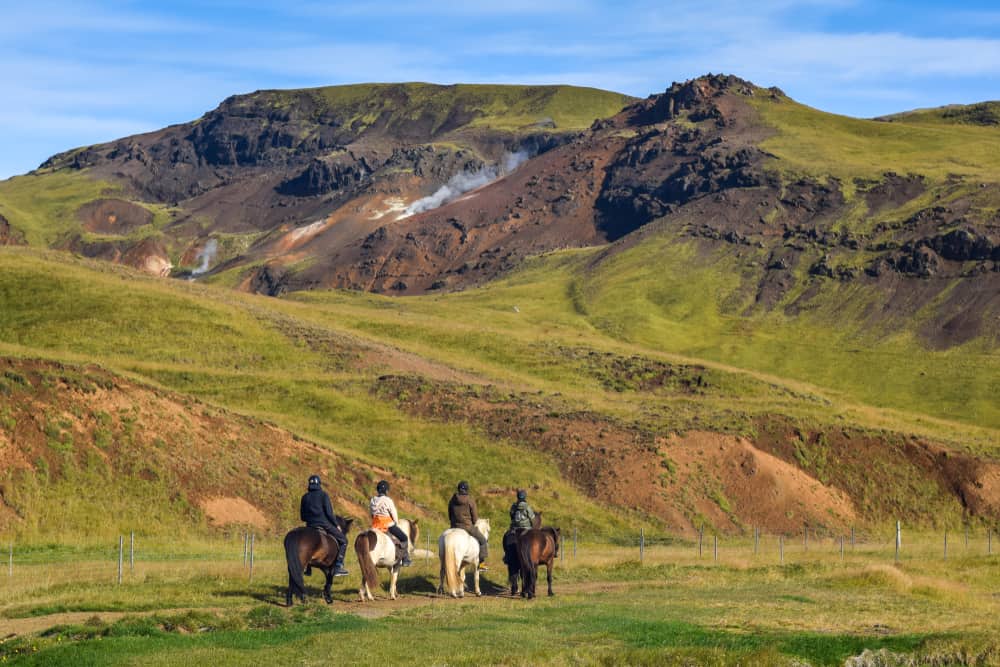
Regular exercise and training keep the horse healthy and excellently fit. However, it is recommended to take your animal to the vet for a detailed checkup before the journey. There are a few factors that will affect the horse’s overall fitness.
For instance, senior horses often have some health issues, like arthritis, and can’t spend hours on the trip and keep up with speed. It is the same with recently injured animals.
Keep in mind that horses tend to follow their team regardless of fatigue and pain. Therefore, you should take care to prevent overload. Tired animals can quickly stumble and are prone to injuries, so you should be careful and responsible.
The best option is to keep a reasonable pace, make frequent stops, and provide adequate riding equipment and enough food and water during the journey. Otherwise, you can face irreparable damage.
Keep in mind that there are a few techniques to improving a horse’s fitness, but it is a long process. It will be easier with a young, energetic, and healthy animal, but you should be less demanding with an older and less hardy horse.
Existing terrain and footing
Be aware that a horse can’t maintain the same rhythm of gait throughout the journey, and it often depends on the riding conditions. Every horse will slow down when facing unfamiliar and uncomfortable terrain, prolonging overall travel time.
As you can guess, it is not the same if you travel across the plains or the steep hills. Moving up and down will cause more stress on the horse’s cardiovascular system and limbs, so it can’t go as fast as over flat terrain.
Additionally, the hard, rocky, sandy, muddy, and bumpy ground will negatively impact the horse’s joints and hooves. Therefore, it will slow down the pace to avoid injuries. The best option for long-distance traveling is grassy fields.
Weather conditions
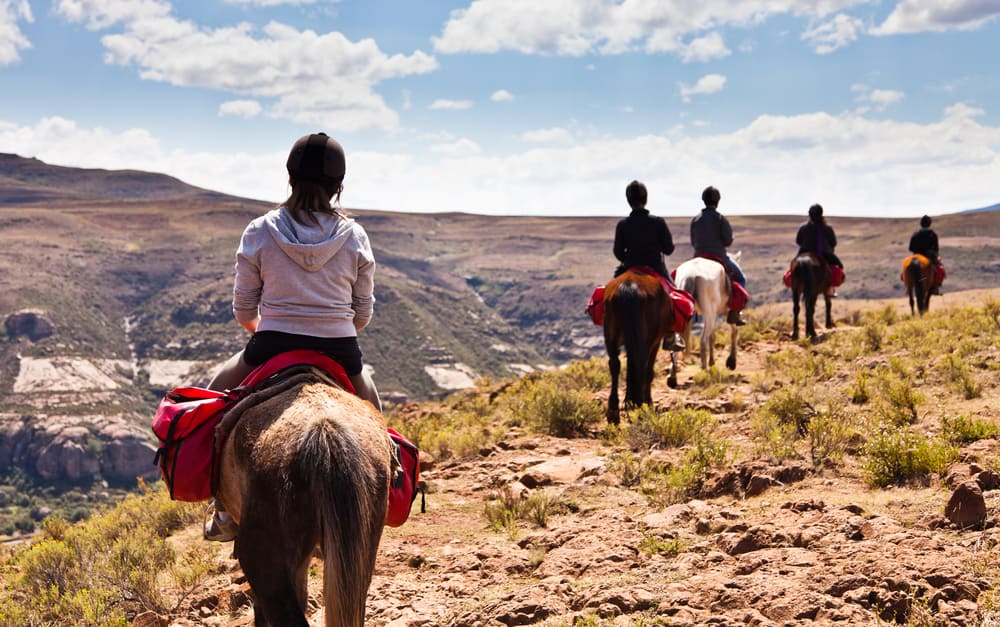
Always check weather conditions in advance and avoid taking a trip when the day is too hot or cold. Believe it or not, weather can significantly affect horseback rides, particularly when you plan a full-day trip.
Most horses do the best at the optimal temperatures of 70 and 90 F (21 – 32 C). Rainy days will slow your animal down, primarily because of the slippery ground. Plus, no one horse won’t enjoy getting wet. You can expect your horse to look for shelter after 2 to 7 miles (3 – 11 km) spent on rain.
In most cases, an average horse can travel about 10 to 20 miles (16 – 32 km) when it snows and temperatures are low. After that, they will seek warmth.
Additionally, extreme weather can cause severe horse injuries and illnesses. For instance, dehydration during hot days will cause a low level of electrolytes that is always followed by severe health consequences.
Keep in mind that hot, windy weather with low humidity can cause quick sweat to evaporates. You won’t notice sweating in such a situation because it dries quickly, but be aware that the horse can still lose electrolytes.
On the other hand, traveling during the windy and freezing days without adequate protective gear will probably cause muscles to stiffen, while frozen ground can hurt your horse’s joints and hooves.
Feed, water, and rest the horse
Fed and rested horse that got enough water will quickly complete a long ride and recover after that. Always check if you can find adequately arranged and accessible water sources on the trail, offer water to your overheating horse regularly and let it cool down and take a rest as much as it needs.
Properly fitting tack is one of the crucial things you should consider when riding the horse, especially when going on longer journeys. It is the same with the saddle and bridle.
Inappropriately fitting equipment will significantly influence your trip, shorten the distance you can pass during a day, and leave you unsatisfied and disappointed.
An additional problem is losing a shoe while traveling over the rocky terrain, making it impossible to continue the journey.
Rider’s skills and fitness
Finally, you have to be sure of your physical fit and capability to go the long distance in one day. For instance, if you are not skillful enough to guide your horse over rocky terrain or puddle, you can find yourself get stuck in the middle of nowhere.
Always check your stamina by traveling a few shorter trails before a long trip. As you have already known, riding a horse for hours is tiring and can be pretty painful. Even the most experienced riders will struggle to handle such an effort.
You can ride an average, healthy and energetic horse for 25 and 35 miles (40 – 56.5 km) in one day in ideal conditions. However, most of them will successfully handle only 15 and 20 miles (24 – 32 km) a day with enough water, food, and rest. Keep in mind that distance traveled also depends on you, weather conditions, terrain, and equipment you use.
Sharing is caring!
Related posts:
- How Fast Can a Horse Run? (Top & Average Speed)
- What Is a Baby Horse Called? (9 Facts About Baby Horse)
- How Much Does a Horse Weigh? (Average Horse Weight Chart)
- How Tall is a Horse? (Average Horse Height Chart)
Leave a Comment Cancel reply
Save my name, email, and website in this browser for the next time I comment.
Also Reading

12 Top Horse Documentaries Personally Recommended by Equestrians

Types of Horse Bits: Which is Right for You?

15 Top Tips for Renting a Horse Trailer

12 Beautiful White Horse Breeds (True & Fake White Identification)

What are Friesian Horses Used For? (9 Uses)

Are Horses Native to America? Where Do Horses Originate From?

10 Most Common Blue Roan Horse Breeds (With Pictures)

33 Homemade Horsefly Spray Recipes

How Far Can A Horse Run Without Stopping, How Far, How Long?
We’ve all grown up watching movies of cowboys racing their horses across open fields for miles without end, but how far can a horse really gallop without stopping? And how far can horses realistically travel in a day? The answer is nearly never the same and for a good reason. In this article, we will discuss the aspects relating to horse endurance and speed in depth.
How far can a horse travel in a day? Walking steadily, a horse can travel about 20 and 30 miles a day, with an average of 25 miles per day. You might think a galloping horse can travel more miles in a day, but a galloping horse needs to rest every 2.5 miles. A horse will cover more daily miles if kept at a walk or a trot than if ridden at a gallop.
How Far A Horse Travels In A Day Depends on Other Factors
How many miles a horse can travel in a day change, depending on many factors. Beed affects the endurance of the horse. Some breeds, like Arabian horses, can travel longer distances. Young adult horses will also cover greater distances. Horses with lighter riders and over smooth terrain can travel farther. Lastly, a horse that is consistently trained to cover longer distances can travel farther in a day than a horse that occasionally rides all day.
- Weight of rider
- Conditioning of horse
How far can horses travel in a day? Modern horses aren’t worked as much as horses in the past. While horses today can only average between 25-35 miles a day. But, even a hundred years ago, horses could easily travel 35 miles a day. Horses can be conditioned to ride as much as 50 miles a day. High-endurance horses can travel up to 100 miles a day.
In this article, we explore the effects of these factors and others and attempt to answer the question of just how far finally, and for how long, a horse can travel.
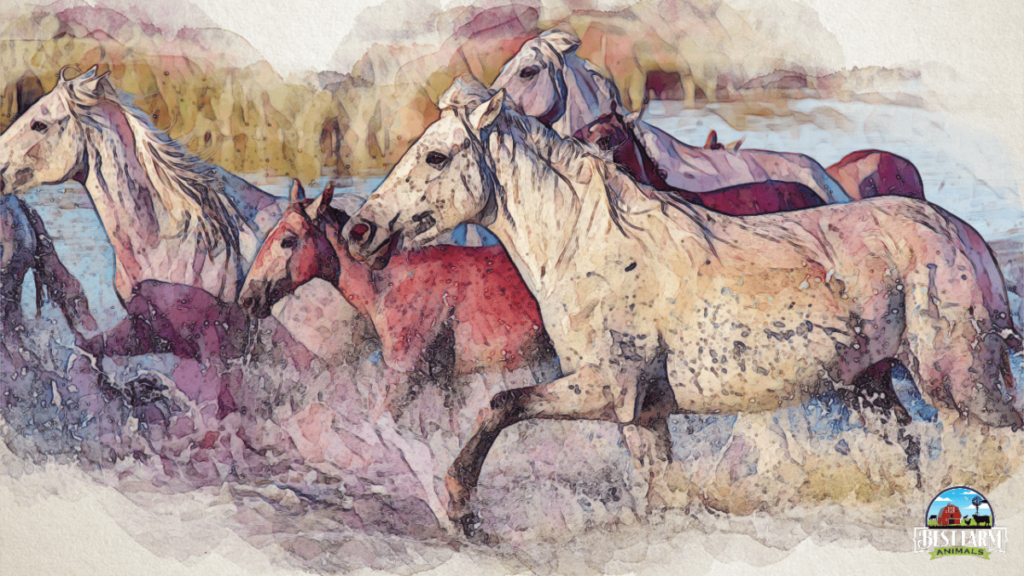
How Far Can You Ride a Horse?
How far you can travel on horseback on a horse depends on the speed of the house. Walking versus galloping will make a difference . While you may assume that galloping horses will travel longer, that is not the case because most horses can travel farther with a ride walking than they can galloping or trotting.
How far you can travel on horseback at a certain speed chart :
These numbers are certainly not the maximum for all horses, but it is the recommended average. Pushing an untrained horse any further or faster than this could result in serious injury. It is possible for a horse to run itself to death.
How long can a horse run? Modern horses can usually run for about 5 minutes, or 2.5 miles before they need to rest. If galloped for the maximum recommended five minutes, a horse should be allowed to rest until it has caught its breath. During recovery, the objective should be between 12 and 16 breaths a minute. Once this rhythm is restored, the horse can be galloped once again.
This can be repeated for up to an hour of galloping time in total per day, meaning around 30 miles could be covered. However, the more frequently the horse is galloped, the longer it will take for it to recover and the slower it will move overall. The hour of galloping may need to be spaced over several hours to allow ample time for the horse to catch its breath in between.
Now that you have a general idea of how fast and how far a horse can travel in any given time, let’s take a look at the different elements involved in regulating these figures.

How Far Can a Horse Travel At a Time?
There are several factors that affect how far a horse can travel at a time. These include age, breed, terrain, diet, and pace. Let’s go more in-depth.
Horse Breeds That Have Higher Endurance
Around 6,000 years ago humans domesticated horses. It was soon discovered they could be used as tools for travel and work, and not long after that did the selective breeding of the ‘strongest’, ‘fastest’, and ‘most beautiful’ horses begin.
For example, Arabians bred and used by cavalrymen and explorers would naturally be better at long-distance traveling than, for instance, a draught horse. It is rational to assume a bigger, heavier horse might have more difficulty traveling long distances than its streamlined, ‘light-footed’ counterpart.
The three strongest horse breeds for endurance are:
- Anglo-Arabian
Age Affects How Far A Horse Can Run
It’s common to hear horses living up to 30 years long. However, at 30 yrs old, no horse could travel more than a couple of miles a day.
A horse’s peak is usually reached between 3.5 – 7.5 years. Within this age period, a healthy horse will have the most stamina and the fastest recovery time in its lifetime. This doesn’t mean an 8-year-old horse cannot travel long distances. It simply means at 8 years or older, the horse will travel slower and need to rest more often.
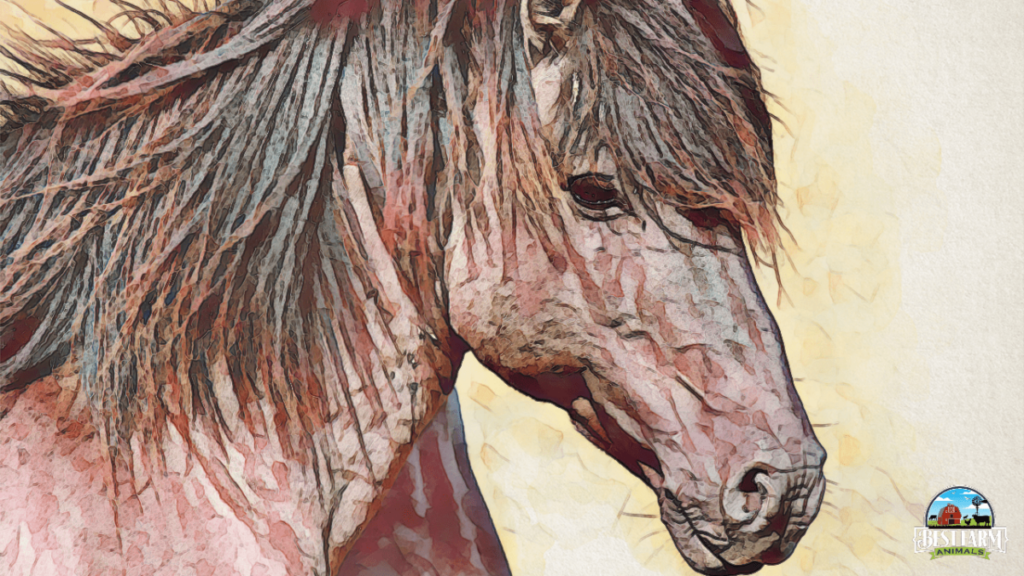
Endurance Training Helps Horses to be Able to Travel Farther At A Time
A horse that’s been conditioned to travel long distances can cover much more ground than an untrained one. Later, we will cover exactly what sort of training and conditioning is used to improve the stamina and speed of any horse.
Weight of the Rider and the Load Impacts Horse Distance
The lighter a rider, the longer a horse can travel without rest. That’s the reason why racing jockeys are smaller riders. It is uncommon to find a heavier jockey. That would put their horse at a distinct disadvantage over horses with lighter riders.
Reducing a horse’s weight will improve the speed and overall distance it can reach. The lighter, the better. A slower horse who that needs to rest more often will cover less distance in any given time.
Terrain Makes a Difference in How Far a Horse Can Travel In A Day
The terrain makes a bigger difference in the distance a horse can cover than most people realize. If the horse is traveling on a stretch of flat, smooth terrain it will move much more easily and faster for longer than if it was moving across a rocky, mountainous region. Sandy ground slows a horse down even more and depletes its energy.
This is why humans take more time to cover the same distance when hiking up a mountain compared to walking across a field.
Diet is Important to Horse Riding Endurance
A malnourished, or underfed horse will become tired quickly.
A healthy diet of alfalfa (which is high in energy), pasture grass, hay, and lucerne mixed with high-fat hard feed benefits a horse’s stamina. It therefore increases the average distance it could travel at any one time.
High-protein feed, on the other hand, would result in your horse needing more water, to urinate more often, and sweat more, all things detrimental to traveling fast and far.
It is also critical that a horse has a sufficient supply of water every day, as well as when traveling, is essential as a dehydrated horse will drop its speed and stamina massively.
Running Pace Determines The Distance
An inexperienced rider might think that a galloping horse will go farther in a day than a horse traveling at a slower pace. But, a gallop actually reduces the total distance a horse can go over a period of time. That’s why most endurance riders will never push their horse faster than a canter for most of a race. A strong horse, with intermediate training can only gallop for around 2.5 miles at a time before needing rest.
Cavalry riders, explorers, and couriers of yesteryear discovered early on that the distance-traveling sweet spot alternated between trotting and walking. This ensures the horse moved forward at a steady pace, while not tiring out so quickly that it would need prolonged periods of standing still to recover. Following a trot-walk pattern, with water breaks in between, a nearly entirely untrained horse could be pushed to reach 35 miles a day.
Tack and Equipment Can Help or Hinder Distance Riding
The tack and equipment used on the horse while traveling can make a huge impact on the distance a horse is able to cover. A wrongly fitted saddle or a too small or large bridle can cause enough discomfort to reduce the distance traveled.
In the same way, the rider’s experience can affect the horse’s performance. In most cases, an inexperienced rider will not reach the same distance or speed as an experienced rider.
Shodding Effects Distance Ability
A shod horse has greater protection for its hooves. In a best-case scenario, this might not directly affect the speed or stamina of the horse. But, it will help prevent injuries or sensitivities that might slow down the horse. More serious injuries can completely stop a horse.
While there are benefits to leaving your horses barefoot, it is not recommended during training or intense exercise.
How Far and How Long Can a Horse Occasionally Ride in a Day?
Untrained, a horse can be pushed to cover a maximum of 50 miles a day, assuming the horse is in good health and age. But, this is not a regular distance and should only be attempted occasionally. This would require stamina on both the horse and the rider’s part. It would also require regular stops for qualitative rest and watering. This distance could take 10-12 hours to complete and would not be viable to attempt regularly.
Trained horses like those competing in the Tevis Cup can easily travel 100 miles in 24 hours. The winners of the Cup usually finish before or around the 12-hour mark. This is, however, only done with regular compulsory stops and vet checks.
Which Breed of Horse has the Greatest Stamina?
Some breeds are naturally better suited to traveling long distances. The top three breeds for horse stamina are Arabians, Akhal-Tekes, and Anglo-Arabians.
Arabians are a lighter breed with long powerful legs which allow them to take bigger strides. They originated in what is now the Middle East, where the Bedouins bred them for use in raids on other camps. They are the most common horse to be entered into endurance competitions, and the horse best suited for long-distance travel overall.
The Akhal-Teke, a horse originating in Turkmenistan, is especially well-known for its ability to weather the extremes. In 1935 a group of riders on Akhal-Tekes rode 2,500 miles from Ashgabat to Moscow in 84 days. This included 3 days crossing 235 miles of desert without water.
Finally, the Anglo-Arabian, a crossbreed between an Arabian and a Thoroughbred, is at the top of the list due to the characteristics inherited from the horses it was bred from. Slightly larger in size, the Anglo-Arabian combines Arabians’ endurance with Thoroughbreds’ speed and agility to create a unique horse perfectly suited for long-distance travel.
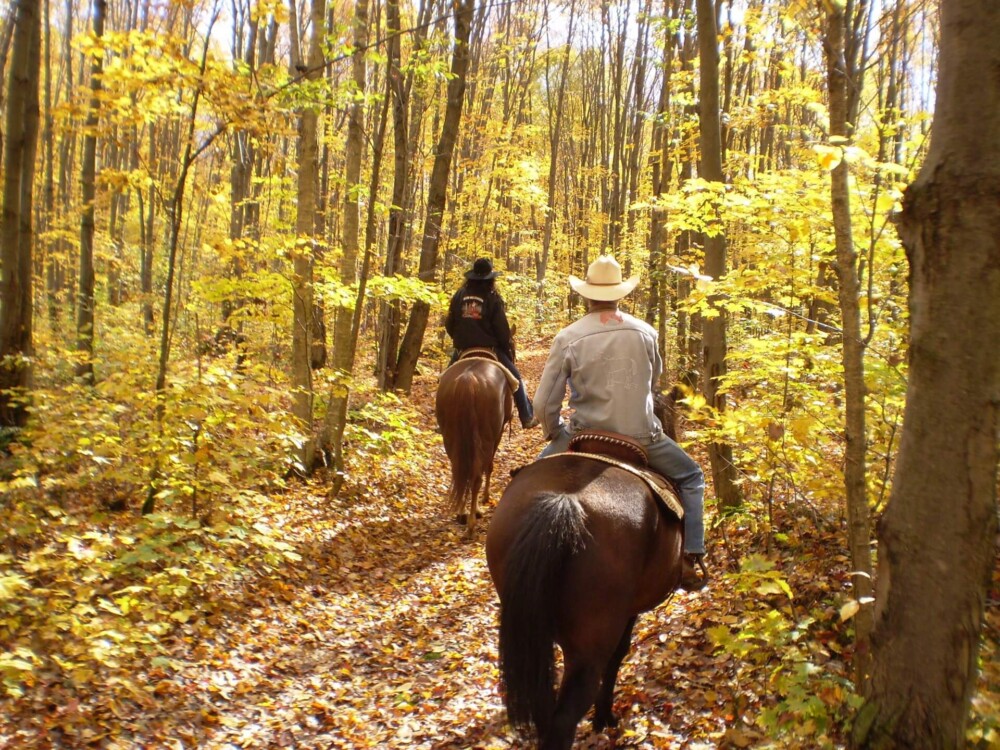
There are other breeds also known for higher stamina than average breeds. They are:
- American Mustang: Mustangs breed in the wild. Due to natural selection, only the strongest horses will reproduce, providing them with naturally high stamina levels.
- Morgan Horse: Bred for stamina. It is known to be able to work all day and still travel at night.
- Rocky Mountain Horse : With a unique 4-beat gait it conserves energy and allows for a smoother ride, both essential to endurance riding.
- Mule: The offspring of a female horse and male donkey , the mule may seem an unusual addition to the list. Due to its breeding, however, it has very impressive muscle endurance allowing it to travel greater distances without tiring.
- Quarter Horse: Their strong-willed temperament means they enjoy a challenge when ridden by an experienced rider. This temperament allows them to travel great distances with the right guidance.
- Hanoverian : Originally used as carriage horses, Hanoverians are muscular, long-limbed horses which make them well suited to traveling long distances.
- American Saddlebred : Initially bred for hunting and cross-country riding, the Saddlebred makes an excellent long-distance traveler.
- Tennessee Walker : As another breed with a 4-beat gait, the energy conservation and comfort while riding makes it an easy choice for riders looking to go the distance.
- Criollo : Native to the Pampas in Latin America, Criollos are tough horses that can be ridden for extensive time periods each day, making them a good choice for traveling far.
Fastest Horse Racing Breeds
If your goal is to cover a great distance in a shorter amount of time, then a fast horse is more important than an endurance horse. Fortunately, many of the endurance breeds are also known for being speedy. You may not be surprised to discover that you can find 80% of all endurance racing horses between these two lists.
Horse breeds known for speed include:
- Thoroughbred
- Standardbred
- American Mustang
How to Train Horses to Travel Greater Distances
Without the right training, not even the fastest breed with the highest stamina level can complete strenuous distances. A trained horse, not bred for its stamina, could easily outlast a perfectly bred endurance horse without training .
Training and conditioning make all the difference in performance.
When training a horse for distance, it is imperative to train gradually. On average, it can take up to a year of training to get your horse to the point where it can comfortably complete 60 or more miles at a time.
Let’s discuss the best methods to increase your horse’s stamina, and condition it for covering longer distances of travel. It is also important to note that all training times below are listed for shod horses. If your horse is barefoot , training time must be doubled. The best shoe type for horses traveling long distances is flat steel shoes.
Distance Training Phase I: Beginner Level
Duration; 6-8 weeks
This period is used to prepare your horse for continuously increasing exercise times and intensity and to condition its hooves and muscle to the work it will do.
- Between 4 and 5 days a week, walk your horse at an active pace. This should not be done on the same terrain every day. It is recommended that you train on as many different landscapes as possible. This can include fields, gravel, mountains, and even sand. Training times should be up to about 3 hours per day at the end of the 6 or 8 weeks.
- Once a week, the horse should be trotted in a lunge. This should not exceed half an hour without rest, and should never exceed 90 minutes overall. The horse must learn to maintain the correct form while trotting (head low, back rounded, and neck extended), and do so in a relaxed manner, so as to perfect its stride.
- Near the end of the beginner period, trotting should be added to the walking training. This should be done at the same pace as with the lunge, and for no more than 20 minutes per session.
- One day a week must be given for the horse to rest. At the beginning of the training period, recovery is essential, and this is impossible without allowing the horse a full day off.
Distance Training Phase II: Intermediate Level Duration; 6 weeks
- Five days per week, follow this pattern; warm-up for 15-20 minutes at a quick walk, then proceed to use the trot-walk formation for increasing amounts of time. By the end of this level, the horse should be able to trot for 2 hours uninterrupted.
- Two days a week should be allowed for rest and recovery. Allow no more than light outrides, or very light lunging.
Distance Training Phase III: Advanced Level Duration; 2-3 weeks
At this level, a comfortable canter should be achieved. Focus on the horse’s fitness levels while ensuring the rider and animal enjoy the exercise.
- 3-4 days per week of training should consist of a 15-minute warm-up, and then alternating between a canter, trot, and walk. By the last week of training, the horse should be able to maintain a canter-trot formation for a total of 90-100 minutes.
- Allow 3-4 rest days now that the training is more intense.
Following the above program will show obvious changes in your horse’s stamina and physique. It will also cover longer distances with much greater ease when kept in trot-walk formation with occasional cantering.
The program above covers the first 3 months of training. Once this intermediate level of stamina has been reached, the intensity of Phase III training sessions should be gradually increased. This training regimen should be interspersed with days in a lunging arena or riding school. The foundation built in the first three months of training will serve as the point for further developing your horse’s abilities.
To reduce the chances of injury or illness during training, it is important to take a holistic approach to the program and listen to your horse. If they start a training session on low energy, it is better to add an extra rest day instead of pushing them to complete the workout.
If a sensible, dedicated approach is taken, the difference in the way your horse performs may astound you.
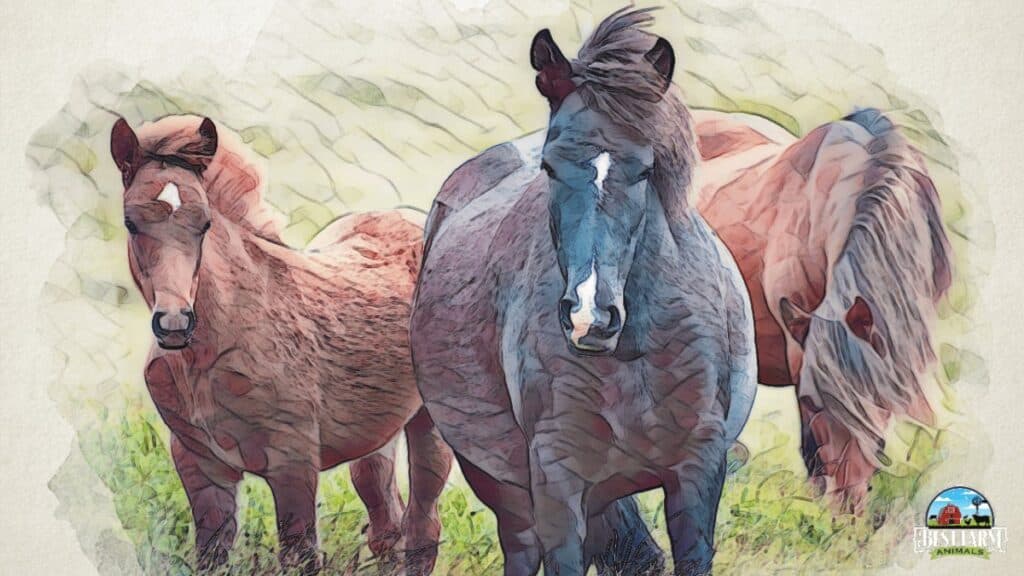
Horse Travel FAQs
How far can a horse run without stopping? Horses can run 2.5 miles without stopping unless they have been conditioned to run farther. The average horse is stabled or kept on a pasture and doesn’t spend large portions of its time running or galloping and isn’t as in shape as horses were five decades ago when they were used for travel more often.
How far can a horse travel in 3 hours? A horse can walk 4 miles an hour and trot eight to twelve miles an hour. If a horse is conditioned and fit, it can usually cantor between 12-15 miles an hour and gallop 25-30 miles an hour. But, most pet horses are not conditioned enough to sustain a gallop or cantor non-stop for an hour and will need to rest after a few miles.
How Many Kilometers Can a Horse Run In A Day? A horse can run about 40 to 55 kilometers in a day, depending on how well conditioned it is. A well-conditioned horse can run up to 80 km a day with some horses able to run even farther. But, you should not attempt to run an average horse that far because it can cause injury and harm the horse.
My Favorite Equine Resources For Horses and Donkeys
This list contains affiliate products. Affiliate products do not cost more but helps to support BestFarmAnimals and our goal to provide farm animal owners with accurate and helpful information.
Squeaky Chicken Toy is hilarious to watch and the horses love it! It’s not super tough so keep it away from dogs.
Dewormer with Ivermectin : I use this for my horses and my goats. Duvet makes a great dewormer. I switch between the Ivermectin one and one like this one so the worms don’t get immune to it.
Manna Pro Apple Flavored Nuggets are a delicious smelling treat that my horses go crazy over.
Equinity Amino Acid Supplement for Horses makes a big difference for any horse that’s struggling with arthritis, hoof issues, or just generally. It’s great for older horses who can’t absorb all the nutrients in their food as well!
Manna Pro Weight Accelerator helps older horses gain weight and stay healthier! This was especially helpful when one of my older horses lost weight over the winter and helped her regain her weight over the summer!
Farnam Fly Control goes on the horse or donkey and will keep the flies off your sweet pet. It makes horses way more comfortable and will keep sores from getting infected as well.
Wound Kote protects sores and wounds. It acts as an antiseptic and helps wounds heal faster. It works on both my horses and goats.
Ever since ancient times, horses have been used as a means of transport and work by people of all classes, from peasants to kings. They can reach extraordinary levels of endurance with the correct training and riding.
From the days of the Pony Express, and the years of war where cavalrymen and steeds were used, until today where most endurance horses are prized mainly for their racing abilities, horses’ stamina and speed have been of utmost importance whether as a matter of pride, or the difference between life and death.
Wikipedia: Akhal Tekkes

How Far Can A Horse Travel In A Day? The History On Travel By Horses & The Furthest Distances Achieved

Horses have great stamina and have the ability to travel for many miles in a day, but how far can they travel? When people traveled by horses in the past how far could they travel daily? I did some research on the history of horses and people and how they traveled.
How Far Can A Horse Travel In One Day?
Horses can travel many miles in the span of twenty-four hours. There is actually a competition that judges the horse on this called endurance riding. Endurance is a sport that judges the horse’s stamina and ability to go up to 100 miles in the course of one day. The record time for a horse to do 100 miles in one sitting is 5 hours and 45 minutes. Average horses can go around 35 miles in one day. The young and healthy horse, however, can travel between 50 and 75 miles in one day.
How Many Miles Can A Horse Go When Pulling A Carriage?
Traveling on the oregon trail.
Horses pulling covered wagons and carts along the Oregon trail were a common sight to see in the wilderness during the 1840s all the way through the 1860s.
These horses and people needed to travel through many different terrains from mountains to prairies, and even Native American territories.
On average, this long line of covered wagons only covered about 15 miles a day on average. This is probably why it took so long to journey from their original settlement all the way to Oregon.
Stagecoaches of the Wild West
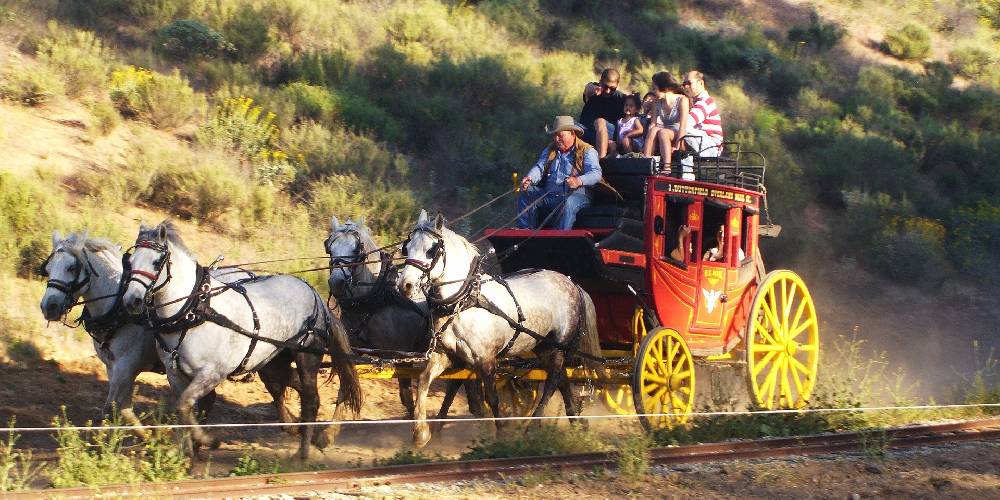
Stagecoaches were a form of transportation from town to town as well as a means of delivery and money transfer that started being used in the late 1850s. Stage coaches are large carriages typically pulled by a team of four to eight horses.
Stage coaches were pulled through several types of terrain and Native American territories. There are many stories of Native Americans attacking and raiding stage coaches. It was not entirely uncommon to have a stagecoach raided and robbed.
On average, horses that pulled stagecoaches could travel around 30 miles per day for each team. When coaches would get to a new town they would get a fresh team of horses and continue their journey so they weren’t wearing their first team out too much.
Traveling With An Average Carriage Horse
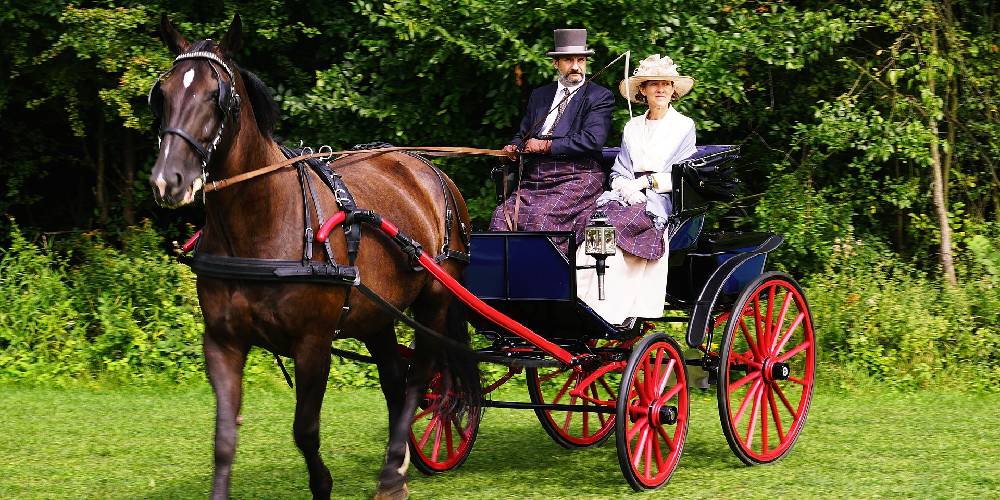
The carriage horse, or horse and buggy, were used for a very long time and only stopped being used around the 1920s. These horses were used to transport people and families to any destination they wanted to go.
These horses were only really used to travel up to 25 miles per day and rarely more than that. The horses that pulled these buggy’s and carriages were often owned and cared for by the family that used them, so the horses weren’t often overworked so they could serve the family longer.
How Far Can A Horse Travel With A Rider?
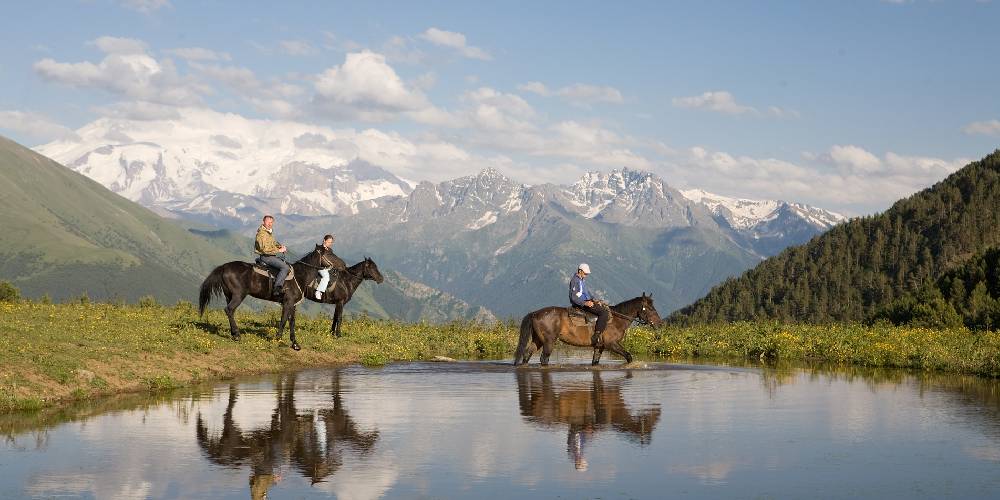
Usually, horses carrying a rider can travel around 50 miles in one day, but endurance horses, if moving for an entire day, can travel well over 100 miles.
Horses who carry a rider over many miles will tire faster than a horse who has no rider at all.
What Types Of Horses Can Travel The Furthest In A Day?
Hotblooded horses.
Hotblooded horses are horses that can travel the furthest in one day. Arabians are one hotblooded breed that can travel the greatest distance and are of the top choices for endurance horses.
It was actually an Arabian that traveled 100 miles in 5 hours and 45 minutes and achieved the record for the fastest 100 miles.
Another great option for a horse that can cover ground quickly and can keep moving for long periods of time is a Thoroughbred . These horses are used in racing for their incredible stamina making them an ideal choice for a riding horse that is needed to cover a great stretch of ground. Their tremendous speed makes them cover ground faster than most horses, as well as give them a great advantage over warmbloods regarding speed, energy, and stamina. The average horse of this breed can travel, with a rider astride them, up to 45 miles in one day. If the horse is very well taken care of and used for a stamina-required sport, they could travel well over 50 miles in a day.
Warmblooded Horses
Warmblooded horses are the next choice of horse for riding distances. Warm-bloods are often chosen as 3-day eventing horses because of their great stamina and jumping ability. These horses are heavier and often slower than their hotblooded cousins, but that doesn’t mean they can’t cover great distances.
Appaloosa horses are a breed that was bred and developed by the Nez Perce Native Americans. This warm blood is known for its stamina and durability as it was bred to be used and ridden in the wilderness of North America. This breed can easily cover up to 50 miles per day.
The Mustang is another breed that makes a great horse for traveling long distances. These hardy horses are actually the wild horses that roam all over America. This breed, because of its history in the wild, is used to constantly moving and can most likely cover around 50 or more miles in one day.
FAQs On The Distance A Horse Can Travel In A Day

What Breed Can Travel The Greatest Distance In A Day?
The Arabian.
Arabians have the best stamina and agility of any breed of horse. They are the best endurance horse that you could ever get. The Arabian is a breed that is full of energy making them able to keep going and going and going.
It is this breed that I can confidently say can travel the furthest of any other horse in one day.
Do Horses Need Breaks When They Are Traveling All Day?
Yes it is important that your horse has breaks.
Horses will need to re-hydrate during a long ride because if you are riding all day they are most likely going to be sweating. It is good to get off and let your horse rest from carrying you for so long. You can dismount and walk your horse for a mile or two before getting back on so the horse can relax and recover from the weight of you, the rider, on their back.
Can Horses Travel Further With A Rider Than When Pulling A Carriage?
Yes, horses can travel faster and further if they are just being ridden rather than pulling a cart or carriage. This is because pulling a heavy buggy, cart, or carriage is much more physically taxing than if the horse just needs to carry a person.
Hailey Sipila
Horses have been my passion ever since I can remember. At school, I was known as that weird horse girl, and I would read horse encyclopedias for fun. Over the years since those days, I have only learned more. My experiences with horses of a variety of breeds have taught me a lot. Now I want to share what I know with you!
Recent Posts
How to Tack Up a Horse: English Style
For those of you who are just starting to get into the horse world, or are just curious as to what all goes into riding and caring for horses, this is the place for you! As you may already know,...
Horse Names That Start with the Letter M
M has been wildly requested for horse names for some reason! Here are all my favorite horse names that start with the letter M! Female Horse Names Starting with the Letter M:...

How Far Can A Horse Travel In A Day?
As an Amazon Associate we earn from qualifying purchases.
Horses are remarkable animals and are known for their incredible endurance and speed. But when it comes to travel distance, just how far can a horse travel in a day?
Table of Contents
So How Far Can A Horse Travel In A Day?
The answer depends on a variety of factors, including the horse’s age, breed, and fitness level. Generally, a healthy and fit horse can travel up to 20 miles in one day. However, this distance can be increased if the horse is used to long-distance riding and is in peak physical condition. A horse that is trained for long-distance riding can travel up to 30 miles in a single day, while a horse that is used to carrying a rider and baggage can travel up to 40 miles.
Horses can also travel faster if they are carrying a light load and if the terrain is flat. For example, a horse can travel up to 30 miles per hour on a flat surface with a light load.
The amount of time that it takes for a horse to cover a certain distance also depends on the terrain. For example, a horse can cover a 10-mile distance over a flat surface in approximately one hour, while it will take approximately two hours to cover the same distance on mountainous terrain.
In addition to the distance and speed, the length of time that a horse can travel in a day also depends on its fitness level and the terrain. A horse that is in peak physical condition and used to long-distance riding can travel for up to 8 hours in a single day. However, this time can be reduced if the terrain is challenging and if the horse is not used to long-distance riding.
To ensure that a horse is able to travel safely and comfortably for long distances, it is important to provide it with proper nutrition and care. Regular exercise, proper hydration, and access to rest stops are also essential for a horse to be able to cover long distances in a single day.
In conclusion, the distance that a horse can travel in a single day depends on a variety of factors, including the horse’s age, breed, and fitness level. Generally, a healthy and fit horse can travel up to 20 miles in one day, while a horse that is trained for long-distance riding can travel up to 30 miles. With proper care and nutrition, a horse can cover long distances in a single day, with some horses capable of traveling up to 40 miles.
How Long Can A Horse Live With EPM? What is EPM in Horses?
How Far Can A Horse Travel In A Day With A Carriage?
A horse-drawn carriage can travel up to about 25 miles in a day, depending on the terrain, the weight of the carriage, and the strength and endurance of the horse. On flat terrain, with a light carriage and a strong horse, a horse-drawn carriage could travel as many as 30 miles in a day. However, if the terrain is hilly, the weight of the carriage is heavy, or the horse is not particularly strong, the distance a horse-drawn carriage can travel in a day could be as low as 10 miles.
How Far Can A Horse Travel In A Day Running

A horse can typically run for up to 25 miles in a single day, depending on its fitness level and the terrain. The horse’s speed and endurance will also be affected by the environment, temperature, and the type of terrain it is running on. Generally, horses can maintain a steady pace of about 5mph for a prolonged period of time. Over longer distances, horses can reach speeds of up to 25mph, but this will depend on the horse’s physical condition, the terrain, and the environment. Generally, a horse should rest for a few hours between long runs, allowing them to recover and refuel.
Does Reining Hurt Horses? The Sad Truth

How Far Can A Horse Travel In A Day? Final Thoughts
Answering the question of how far a horse can travel in a day is a tricky one. It depends on a variety of factors, such as the horse’s age, breed, and overall health and fitness. As such, it would be difficult to pinpoint an exact number.
Beyond that, the amount of time and terrain the horse covers also play a big role. For instance, a horse might be able to cover more distance on flat terrain during a longer period of time compared to a hilly landscape in a shorter amount of time. Additionally, the horse’s rider or handler will likely factor into the equation as well, as their experience and skill level can affect the horse’s performance. All these variables make it hard to answer how far a horse can travel in a day.
For more information on long distance horse riding follow this link.
Amazon and the Amazon logo are trademarks of Amazon.com, Inc, or its affiliates.

Hey there, I’m Jasmine! I’m a total horse fanatic and have been working with these amazing animals for as long as I can remember. I’m passionate about sharing my love for horses with others and helping them learn more about these majestic creatures. As a professional horse trainer and riding instructor, I’ve developed a deep understanding of equine science and am committed to the welfare of horses. That’s why I founded OwnTheHorse.com, a blog where I share my knowledge and insights with fellow horse enthusiasts. I love connecting with my readers and building a friendly community of horse lovers. Whether you’re a seasoned equestrian or just starting out, I’m here to help and inspire you. Above all, I’m a friendly and compassionate person who truly cares about the well-being of horses and their human companions.
Related posts:
- Top 3 Best Buddy Saddles Reviewed
- Can Horses Eat Carrots? Here’s What You Need To Know
- The 5 Best Saddles for Arabian Horses
- Can Horses Eat Blueberries?

How Far Can A Horse Travel In A Day? (A Complete Guide)
If you are planning on using a horse as a mode of transport, you need to know how far you can go.
Horses can cover approximately 20 miles daily. However, there are horses that have covered over 100 miles in less than a day.
While horses can travel 20 to 30 miles daily or more, it’s not recommendable for their health in the long-term. This is evident with famous races in the past, like the 1892 race, where horses covered 350 miles in three days (approximately 117 miles daily). This race killed 13% of participating horses showing it’s not a good idea to subject horses to long travel.
To reduce risk, riders use techniques like employing different stages and changing horses. This can be seen with Pony Express riders in the 1860s. The riders who used horses to deliver mail and newspapers averaged 10 miles per hour but changed horses after every 25 miles. By doing this, the riders were able to cover 80-100 miles daily.
How Far Can A Horse Run Without Stopping?
Most horses can run for 2 miles without stopping. Some breeds like Arabian horses can run even faster i.e., 2.5 miles before getting tired. This translates to 25-30 mph. However, there are horses which have run faster than this. For instance, the fastest a horse has ever run nonstop on record over a short distance is 55 mph.

Factors Affecting How Far A Horse Can Travel In A Day
The distance a horse can travel in a day will vary depending on several factors discussed below;
1. The Pace You Set
A horse can travel further or a shorter distance depending on the pace you set. A typical walk, trot, canter, and gallop vary in speed i.e., 4 mph, 8-12 mph, 12-15 mph, and 25-30 mph, respectively. Typical horses can walk for eight hours with ease, which translates to 32 miles. Fit horses can cover more distance when trotting or cantering periodically.
Given that horses follow the rider’s cue, the pace you set for your horse will determine how far he/she is able to go in a day. When traveling a long distance, the speed is bound to vary. However, in most cases, horses can walk for 8 hours. If your horse trots, canters, or gallops occasionally during such a voyage, he/she can cover over 32 miles in a day.
A horse can fail to attain a certain pace or travel faster, depending on the terrain. Navigating up steep hills or down slopes is very challenging for a horse’s limbs. It also puts undue pressure on a horse’s cardiovascular system making the horse tire faster than when traveling on even ground. Rocks or hard ground also have the same effect. A rocky path will strain your horse’s joints and hooves, making it impossible to go fast. Sand and deep mud are equally stressful to a horse’s ligaments and tendons.
If you are traveling up/down steep slopes, rocky ground, sand or deep mud, your horse won’t be able to travel far. Such terrain also increases the risk of injury.
The weather also plays a critical role. Long rides are bound to dehydrate horses. Like humans, horses sweat. However, they tend to sweat more and lose lots of electrolytes through sweat increasing risks of suffering from heatstroke, among other serious conditions.
If you are riding your horse on a hot and humid day, you won’t be able to travel far. Your horse will require frequent stops and a lot of water and electrolytes throughout the journey. Horses perform optimally in cool weather. Extreme weather will compromise optimal performance.
4. Number Of Breaks
As mentioned above, horses can run nonstop for 2.5 miles. However, when covering long distances, you can’t canter your horse all the way without stopping. If the sun is out, you’ll need to stop frequently to drink water and replenish electrolytes. Your horse may also need to graze occasionally during a long trip.
If you break too often, you’ll obviously cover less distance. However, your horse will get an opportunity to drink water and graze. One of the main signs of an exhausted horse is lack of normal thirst and appetite. Stop immediately if your horse doesn’t want to drink water or eat after a long walk.
5. Horse Breed
Your horse’s breed will also determine how far he/she can travel in a day. Some horse breeds are more athletic than others. If your horse is tall and slim, his/her chances of traveling further in a day are higher than his less athletic counterparts. Horses that have an Arabian heritage tend to have an advantage.
Arabians are known for covering long distances in adverse conditions. Tall and slim Arabians will cover more distance faster than stockier and shorter horse breeds. However, there are stocky horse breeds (such as stocky quarter horses ) that have endurance matching that of donkeys and mules .
6. Horse Fitness And Relationship With Your Horse
A fit horse can travel further naturally. If you have a fit horse that you have been riding often, he/she can cover eight hours of walking comfortably. Like humans, fitness is an important determinant of physical ability. A horse that exercises occasionally won’t have the stamina to endure hours of travel. If he does, he’ll be too tired/sore.
The level of training you put your horse through on a regular basis will determine how far he/she can travel in a day. You shouldn’t set on a voyage with a horse that isn’t in shape. It also matters how you relate with your horse. In fact, horse fitness is secondary during long voyages. You need to know how to control your horse; otherwise you won’t be able to travel long distances with ease. You should also tell when he/she gets tired to avoid overexerting him/her. Tired horses exhibit signs which take time to identify if you don’t have a relationship with the horse.
7. Horse Health
Your horse should be healthy if you expect him to cover long distances. A fit horse that just suffered an injury won’t be able to go anywhere. Horses are also prone to diseases like arthritis. An old horse with arthritis can’t be able to go far, let alone keep up with younger horses. The same applies to other problems like hoof ailments/injuries. Horses also need training to enhance their cardiovascular health. A tired or ailing horse can’t get far. The horse can also get injured easily or injure you.
8. Condition Of The Other Horses
Horses love to compete and will push themselves to the limit just to keep up with other horses in the group. Therefore, a horse can travel further in a group than alone. However, when riding in a group, the pace should be set by the least fit horse to avoid overexerting or injuring an older or ailing horse in the group.
9. Equipment
A horse’s ability to cover long distances can also be affected by poorly fitted equipment. Besides hampering a rider’s comfort, poorly fitted saddles can injure a horse. The saddle and bridles must be in good working condition and fitted properly before going for long rides.
We have created an easy to read, step-by-step guide on how to fit a saddle onto a horse which can be read here .
10. Condition Of The Hooves
Lastly, your horse’s hooves need to be in good condition if you expect him/her to cover long distances over the shortest time periods. Your horse’s hooves should be examined and trimmed after a couple of months. If you plan to trail ride your horse, you should invest in horse boots as well to protect the hoof walls allowing him/her to cover as much ground with ease.
Horses can travel 20 to 30 miles a day. They can surpass this range based on many factors discussed above. It matters how you pace your horse, the weather, terrain, horse breed, number of breaks you take while riding, horse fitness, and overall health, among other factors.

How Far Can a Horse Travel? Horse Running Endurance Explained
By: Author Henrietta Szathmary
Posted on Last updated: 08/04/2022

This post may contain affiliate links. We earn from qualifying purchases. Learn More
One of the reasons why humans domesticated horses was their ability to cover long distances within a relatively short time span.
While this is not a necessity today, horses still impress us with their remarkable endurance on many occasions.
Wild horses, for example, often travel many miles a day in search of food and water. They do this mostly in walk and trot as these are the most efficient gaits, cantering only in the event of danger.
Certain horse breeds like the Arabian and Mustang are famous for their stamina and can also cover impressive distances in a day. However, rigorous training and sufficient breaks are necessary to achieve such feats.
How Far Can a Horse Travel in a Day?
Horses can travel on average 30 to 50 miles a day if they are in good condition. However, top endurance horses can travel up to 100 miles in a day with a rider on their back. Factors that determine how far a horse can travel include terrain, weather conditions, fitness, health, and the horse’s breed.
Horses can only run at full speed for 2 to 3 miles before slowing down because of muscle fatigue. However, they can maintain a slower run called a trot for several hours without needing a break.
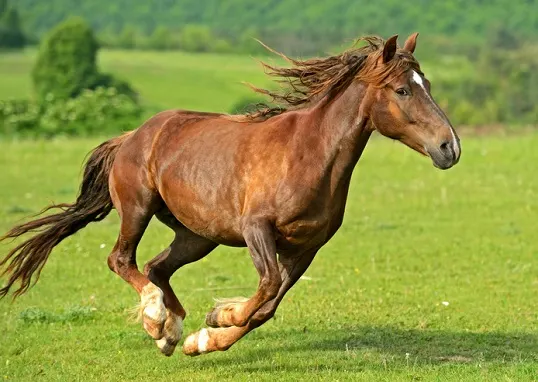
Most horses can generally trot 20 to 40 miles a day at an average speed of 8 mph without a problem. That being said, they will need regular breaks in between running sessions to complete that distance.
In walk, on the other hand, they can travel for up to 8 hours without a break. Since horses average around 4.3 mph in this gait, they could cover 30 to 35 miles daily.
Naturally, horses can travel further without a rider on. However, with adequate conditioning, good nutrition, and regular healthcare, ridden horses will outperform their wild relatives any day.
Horses can also cover impressive distances pulling a carriage.
Depending on fitness, terrain, weather, and the weight of the load, a horse-drawn carriage can travel up to 30 miles a day.
The Pony Express
A shining example from history that highlights the remarkable speed and endurance of horses is the Pony Express. This legendary mail service operated for 18 months along a 1,900-mile (3,100 km) route between Missouri and California.
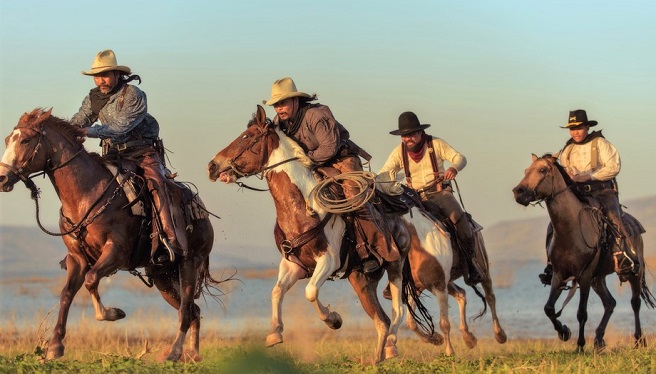
Pony Express horses were ridden or driven at an average speed of 15-25 mph for 15 miles at a time before passing their duties onto a rested horse. This way, riders could deliver mail between the east and west coast of the United States in just 10 days.
Horse breeds most often used for the Pony Express included the Thoroughbred, Morgan, and Mustang.
Although the service stopped in October 1861 due to the arrival of the telegraph, it is remembered to this day as an outstanding example of what horses are capable of.
Horses Were Born to Run
Horses are one of the fastest land mammals on Earth relative to their body size. Throughout evolution, they developed many unique abilities that make them stand out as athletes in the animal world.

One of the reasons why horses are such efficient runners is the structure of their legs. As it happens, horses have little to no muscle tissue in their lower legs, which makes them very light and easy to swing forward.
Moreover, horses have very large hearts that can further increase in size with fitness. This allows adequate oxygenation of the muscles and prevents the early onset of fatigue during exercise.
Horses also possess a unique mechanism similar to blood doping that enables them to run fast over long distances. According to physiology and biomechanics professor Peter Weyand, the spleen of horses stores red blood cells that get released in large quantities when they start to exercise.
As a result, their blood can carry more oxygen to muscles, enhancing their function.
Endurance Horses versus Sprinters
You may have noticed that horses bred for speed and stamina are very lean. Some good examples are the Thoroughbred and Arabian horse which have bodies similar to greyhounds.
This characteristic “runner-look” is the result of more slow-twitch (type I) muscle fibers being present in these breeds compared to others. Slow-twitch fibers work on an aerobic basis and support endurance activities by being resistant to fatigue.
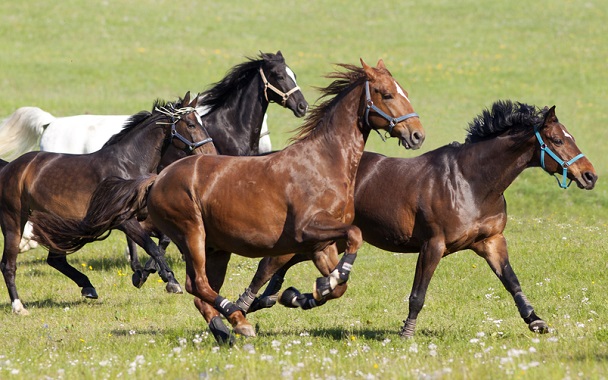
In contrast, horses bred for sprinting like the Quarter horse have more fast-twitch (type II) muscle fibers. These are anaerobic in nature and provide sudden bursts of energy, but are also quick to fatigue.
How Horses Compare to Other Endurance Animals
While horses are one of the top endurance animals on Earth, their stamina is rivaled by many other species.
Wolves, for example, often cover 20 to 30 miles a day searching for prey. However, they can travel over 100 miles in a day when food is scarce.
Sleigh dogs have similarly impressive endurance. During the annual Iditarod Trail Sled Dog Race in Alaska, teams of 12 sleigh dogs cover over 1,000 miles in just 15 days! To achieve this, the dogs often travel at an average speed of 15 mph for six hours straight.
Camels are also among the marathon runners of the animal kingdom. Despite their desert environment, they can maintain an average speed of 25 mph for over 20 miles. However, they tend to travel at a slow walk, covering up to 30 miles a day.
When it comes to running a marathon, the pronghorn antelopes are the ones to beat. These incredible athletes can run at 30 mph for an entire hour and have a top speed of 60 mph.
According to Popular Mechanics , the pronghorn antelope would complete a marathon in just 45 minutes.

Last but not least, let’s not forget about our own species. Humans are remarkably good at long-distance running when compared to other land mammals. Our superb cooling system and upright posture enable us to run over 20 miles without a break, provided we have sufficient training.
What is the fastest a horse traveled 100 miles?
The fastest a horse traveled 100 miles to date is 5 hours and 45 minutes. The record was set at the Tevis Cup by Yousuf Ahmad Al Belushi, riding an 11-year-old Arabian gelding named Jahal Shazal.
The Tevis Cup runs from Utah to California and is considered one of the toughest endurance races in the world. Belushi and his horse completed the 100-mile race with an average speed of 17 mph, a truly astounding feat.
While a hundred miles is the maximum length of an endurance race today, horses used to travel thousands of miles in one journey.
In 1911, for example, traveled 3,200 miles from San Francisco to New York on horseback. She was the first woman in history to ride across Nort America alone, completing the journey in 178 days.
Best Endurance Horse Breeds
While all horses possess remarkable stamina, some breeds stand out when it comes to long-distance riding.
These breeds either developed via natural selection or rigorous selective breeding focused on improving the breed with every generation.
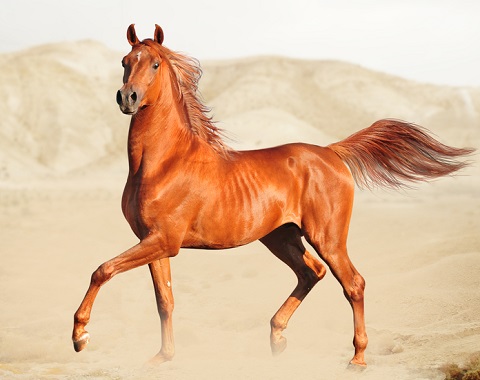
The Arabian is often regarded as the best endurance horse breed there is. This ancient breed developed in the vast Arabian desert, where it adapted to extreme temperatures and scarce water supplies.
Arabians dominate the endurance discipline today due to their superior speed and stamina. They are intelligent, versatile horses with the potential to succeed in various disciplines.

As a result of natural selection, Mustangs developed resistance and stamina that’s unrivaled by most horse breeds. They are born survivors and will travel up to 100 miles a day if need be.
Mustangs are famous for their remarkably hard hooves that enable them to travel over challenging terrain. While many of these horses still roam free, tens of thousands live in captivity, either in holding facilities or private homes.
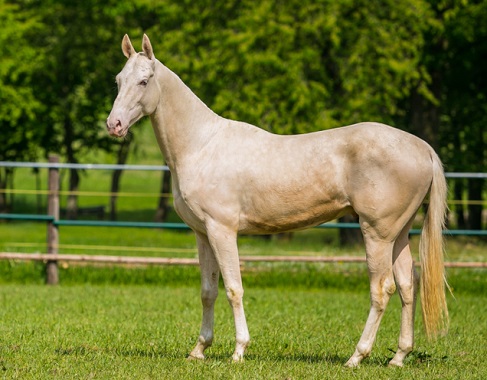
The Akhal-Teke is a rare horse breed from Turkmenistan with a history that dates back thousands of years. A distant relative of the Arabian and Thoroughbred, this unique breed is blessed with excellent endurance and a glowing coat.
Icelandic Horse
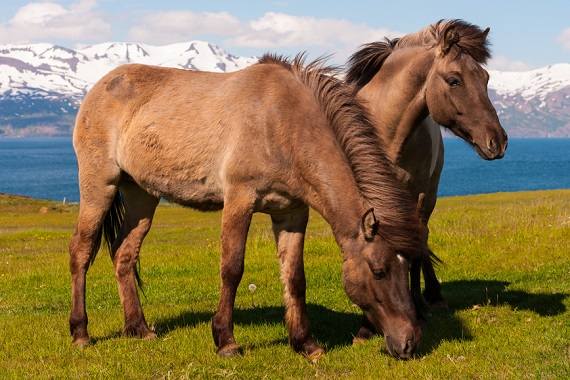
As with the Mustang, natural selection also played a role in developing the remarkable endurance of this ancient breed.
Another reason why Icelandic horses make superb long-distance mounts is their special gaits, the pace, and the tölt.
At pace, these horses can travel at around 10 mph for extended periods of time. Whereas, tölt has a typical speed of 20 mph.
Both gaits are extremely comfortable to ride and give a smooth feeling to the rider.
Mongolian Horse

Originating from the Mongolian steppe, this horse breed is one of the toughest on the planet. Mongolian horses live out all year round and can withstand temperatures from -40 to +40°C (-40 to 104°F).
These horses travel with their nomadic owners to this day and have outstanding stamina. The famous 1,000-km (621-mile) Mongol Derby is ridden on semi-wild native horses that cover 40 km (24.8 miles) at a time.
- Skip to primary navigation
- Skip to main content
- Skip to primary sidebar

- Heartwarming
- Tips For Riders
How Far Can A Horse Travel In A Day?
Modified: Sep 5, 2020 by Wendy Sumner · This post may contain affiliate links ·
I'm sure you've heard the saying, “It is a day’s ride away.” But what exactly does that mean? How far can a horse travel in a day? The truth is, no one answer is correct. In this article, we learn about several factors that can affect the answer to how far a horse can travel in a day.
Horse Ownership has Changed in the Last 100 Years
We rely on the fitness of our cars to get us around today. Therefore, we schedule regular maintenance like oil changes, fluid checks, and tire rotation, etc. Just over one hundred years ago, horses were the primary source of transportation. A horse was considered a tool that needed the best care, maintenance, and fitness. Every farmer understood the necessity of good equine health and conditioning, just like today’s mechanics understand the requirements for keeping vehicles running correctly. Consequently, the average horse in the past was conditioned to travel farther than today’s average horse.
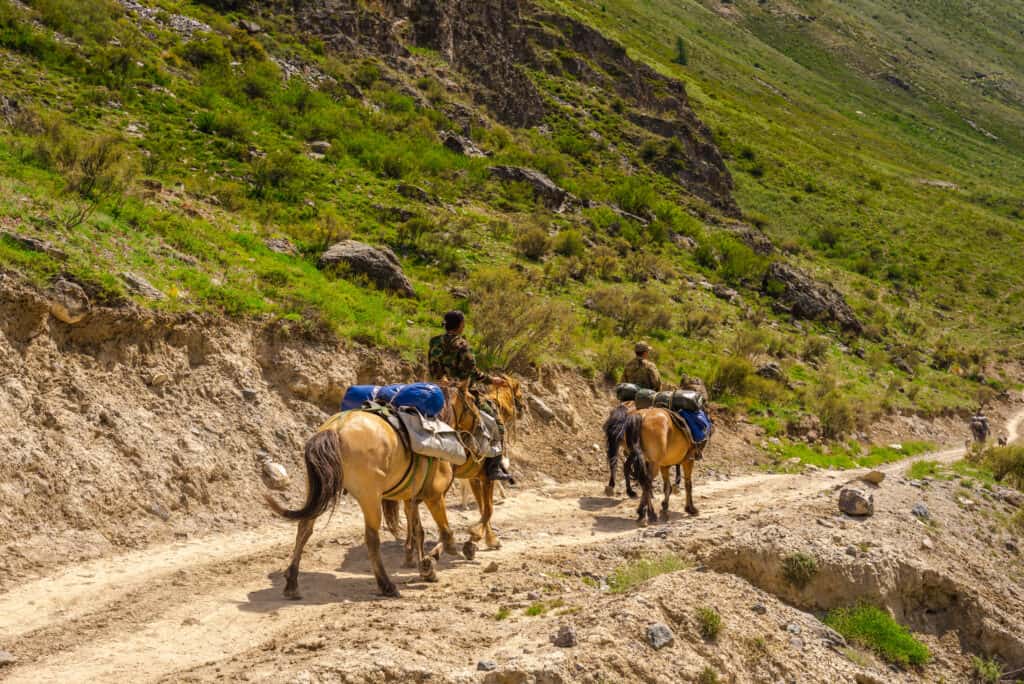
One Day Trip vs. Consecutive Days Trip
Years ago, as well as today, riders needed to take into consideration how many days the trip would take. On average, a healthy horse can travel anywhere from 25 to 35 miles a day. This distance needs to be at a slower pace and with breaks for water. However, asking a horse to keep up this pace for several consecutive days can lead to health problems.
Breeding vs. Backyard Horse vs. Seasoned Equine Athlete
The majority of horses fall into one of these three categories.
- “breeder’s herd.”
These are the horses that are in selective breeding programs to facilitate desired breed characteristics. These horses travel only short distances, usually within their pastures. The tolls of raising foals year after year can have an adverse effect on how far a broad mare can travel. It would take some conditioning to build up to 25 miles in a day.
- The backyard horse.
These horses are the ones that fall into the position of a family member or pet. When asked about how horse ownership has changed in the last 100 years Robert Hilsenroth, DVM, executive director of Morris Animal Foundation , had this to say, “Horses were coming away from the farms, being boarded, and becoming pets. Their value changed from one of horsepower to one of love or companion power.”
Backyard horses that are sound and healthy can usually make 25 or even 35 miles a day. Fifty miles a day is achievable with some physical conditioning. Before taking a backyard horse on a 35+ miles ride, it is of utmost importance that the rider considers the physical condition of the horse.
- The seasoned athlete.
These horses are conditioned and trained to be at the top of their respective disciplines. It doesn’t matter if it is upper-level dressage, three day-eventing, reigning, working cow horse, barrel racing, or other events. These equine athletes receive all the care and treatment you would expect any human athlete would get.
The seasoned equine athletes conditioned for endurance racing are prime examples of how far a horse can travel in one day. Endurance races can be anywhere from 50 miles to 100 miles. The fastest 100 miles race was set by Yousuf Ahmad Al Beloushi on an eleven-year-old gelding. They averaged 17 miles per hour and finished in 5:45:44 seconds.
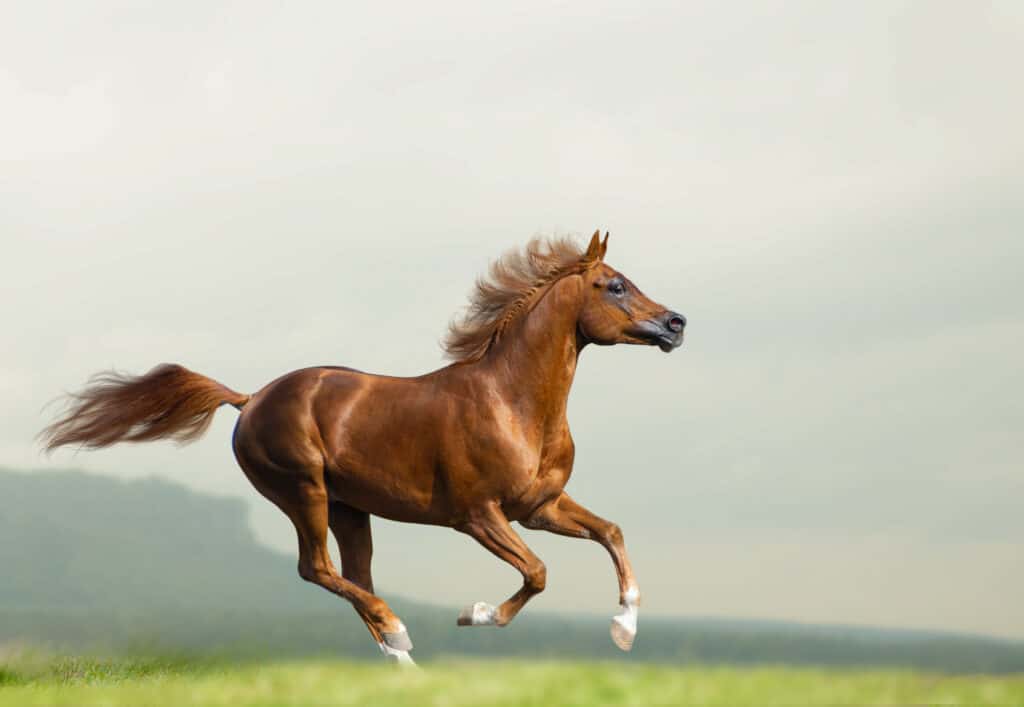
Conditioning for a Riding Discipline
When we ask if an equine athlete is capable of traveling 50+ miles a day, we need to keep in mind the horse’s discipline. Is the horse required to have a short burst of high speeds, like a racehorse? Does the horse need to move in collected meticulous strides like a dressage horse? Are they leaping over cross-country jumps while making the fastest time? Do they make quick side to side moves like a cutting horse? The list can go on!
Conditioning for a healthy horse is very similar for each discipline. Proper nutrition is at the top of the list, followed by regular training and a body conditioning regiment.
At the same time, each discipline also has distinct needs for that particular discipline. Endurance conditioning takes a lot of time and special care to keep the horse healthy during a 50+ miles race.
Traveling on Different Terrain
The terrain that is traveled on can make a big difference. Traveling across flat, open ground will be easier and faster than navigating hilly or mountainous terrain.
Proper Equipment for the Horse
The proper fit of the equipment used can have a significant influence on how far a horse and rider can travel in a day. An ill-fitting saddle can cause serious deep muscle issues along with painful skin rubs. A bridle that is too tight or has a harsh bit can also create problems.
Horses need to have the proper shoes for the terrain. Losing a shoe in the middle of an all-day ride can be an excellent way to cut it short. This is especially true if the terrain is rocky or the horse tends to be tender footed.
Equipment that is well maintained is also necessary. If a billet strap (English) or a latigo strap (Western) breaks, it could be a long walk home.
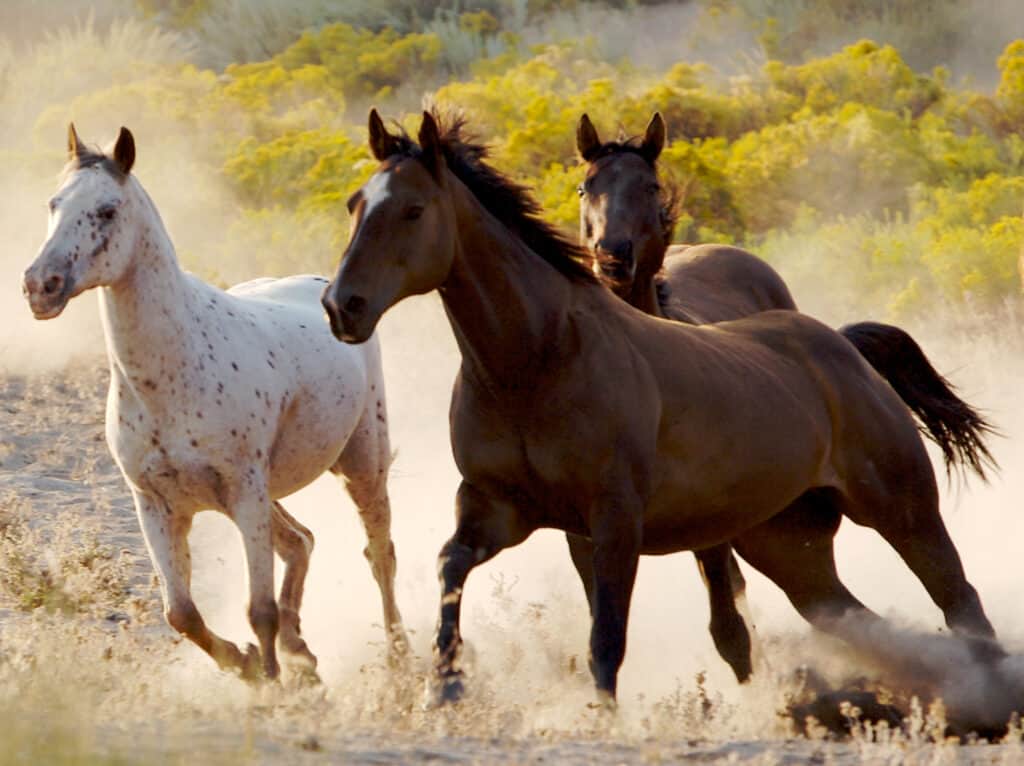
Final Thoughts:
Many factors can affect how far a horse can travel in a day. The distance traveled by the average horse 100 years ago has changed compared to the average horse of today. The most important consideration is the horse’s physical health and conditioning.
Horse Courses by Elaine Heney
- Listening to the Horse - The Documentary by Elaine Heney & Grey Pony Films
- Shoulder In & Out Training for better balance, bend & topline development with your horse
- Over 110+ Polework Exercises & Challenges to Download
- Dancing at Liberty & Creating Connection with Your Horse (11 lessons) - Grey Pony Films
On average, a healthy horse can travel around 25 to 35 miles a day. A horse that is trained to be a top athlete has the possibility of traveling even further. It depends on what discipline they are trained in. Endurance horses are trained specifically to cover distances up to 100 miles in a day.
Did you learn anything new and interesting about our equine friends? Share this article with other horse lovers that you know so that they can learn something, too.
Have you ever wondered how much the average horse weights? Find out the answer here on iHeartHorses.com.
More Fun Facts

Sharing is caring!
Terms and Conditions - Privacy Policy

National Equine
How Far Can A Horse Travel In A Day?
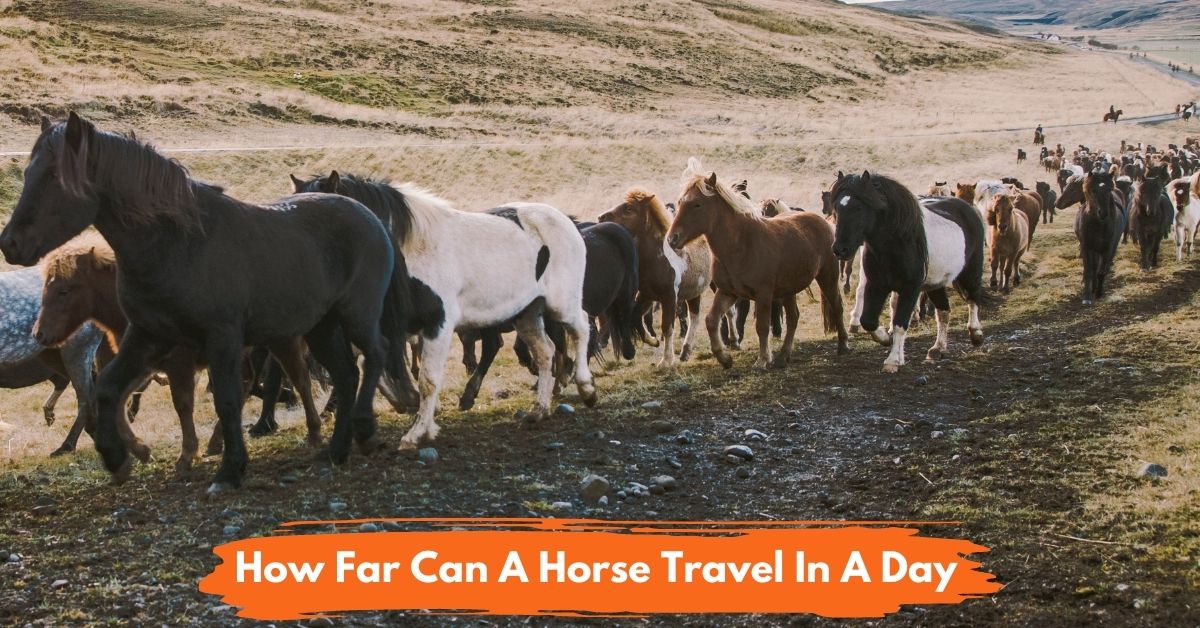
How far can an average horse travel within a day? As long as your horse walks or trots, you can ride your horse from 25 to 35 miles (40 to 56.5 kilometers) without resting.
A trail horse is best for traveling long distances. Trail horses in good shape can withstand long journeys from 50 to 100 miles (80.5 to 161 kilometers) in a day.
Other breeds that can travel long distances include the Saddlebred and Icelandic horse . These horses have a natural, smooth gait that is easy on the rider and horse alike.
If you plan to ride your horse long distances, it’s important to have the right information. You might not know if your horse is going to hold up or if you’re going to run into any unforeseen problems.
This article will go over essential topics that need discussion about the topic.
How Far (Miles) Can a Horse Travel in One Day?
Horses are strong and capable animals that can travel long distances, but the exact distance they can travel in one day depends on a variety of factors, including the horse’s age, breed, physical condition, and the terrain it is traveling on.
In general, a healthy adult horse in good physical condition can travel between 20 and 40 miles (32 and 64 kilometers) in a single day. This distance can vary depending on the type of terrain the horse is traveling on, as well as the weather conditions. For example, a horse may be able to travel farther on flat terrain in cool weather than it could on hilly or rough terrain in hot or humid conditions.
Age and physical condition can also affect a horse’s travel distance. Younger, healthier horses may be able to travel longer distances than older or less fit horses.
It is important to take these factors into consideration when planning a long journey and to provide the necessary rest and care for the horse along the way. This includes providing the horse with plenty of water, food, and rest breaks to ensure that it stays hydrated, nourished, and comfortable throughout the journey.
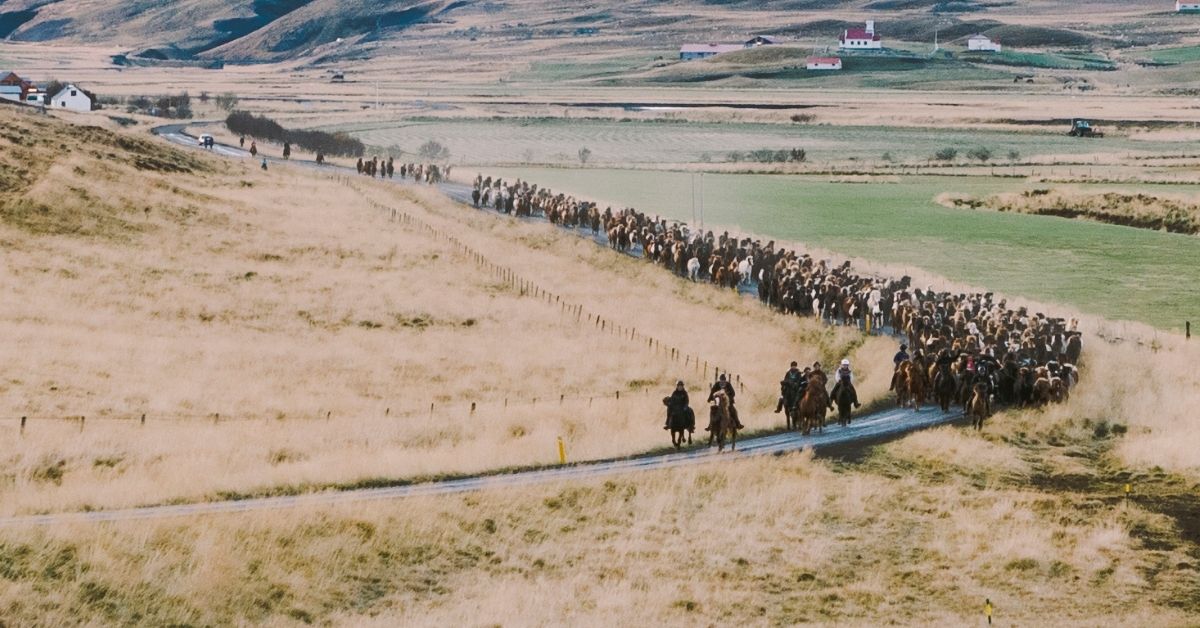
What Factors Affect How Far a Horse Can Run?
There are tons of factors that can affect how far a horse can run in a day. Here are some factors that can impact on your horse’s performance during a day-long trip:
Picking the Pace
How fast you go will play a big role in how long your horse can keep going. If you want to travel further, it’s best to go slower so your horse can last longer.
While the pace might be slower, it doesn’t mean that the journey will take any longer. In fact, going at a moderate pace might get you there faster since your horse won’t get as tired.
When it comes to pacing, you start by gaining a bit of momentum. Find a comfortable pace to cruise at, and finally, ease up on the gas a bit as you’re getting close to your destination.
Generally, a lateral two-beat gait like the jog or trot is best for long-distance travel.
You can include canters and gallops to make the travel efficient. But make sure not to go too crazy with the galloping since it can tire out your horse.
Traveling on Different Terrains
Another factor that plays a role in how far your horse can travel is the type of terrain you’re on. The surface your horse walks on makes a world of difference.
For example, going uphill is obviously harder on your horse than going downhill. That’s because going uphill puts more muscle strain, which can quickly lead to fatigue.
The same goes for different types of surfaces. For example, if you’re traveling on soft and muddy trails, your horse will have to work harder than on a packed trail.
The mud and soft ground can make it difficult to balance and move forward. This is especially troublesome if your horse is carrying more load.
The type of terrain can also affect the pace of your travel. If the terrain is more difficult, you might have to slow down to make it easier on your horse.
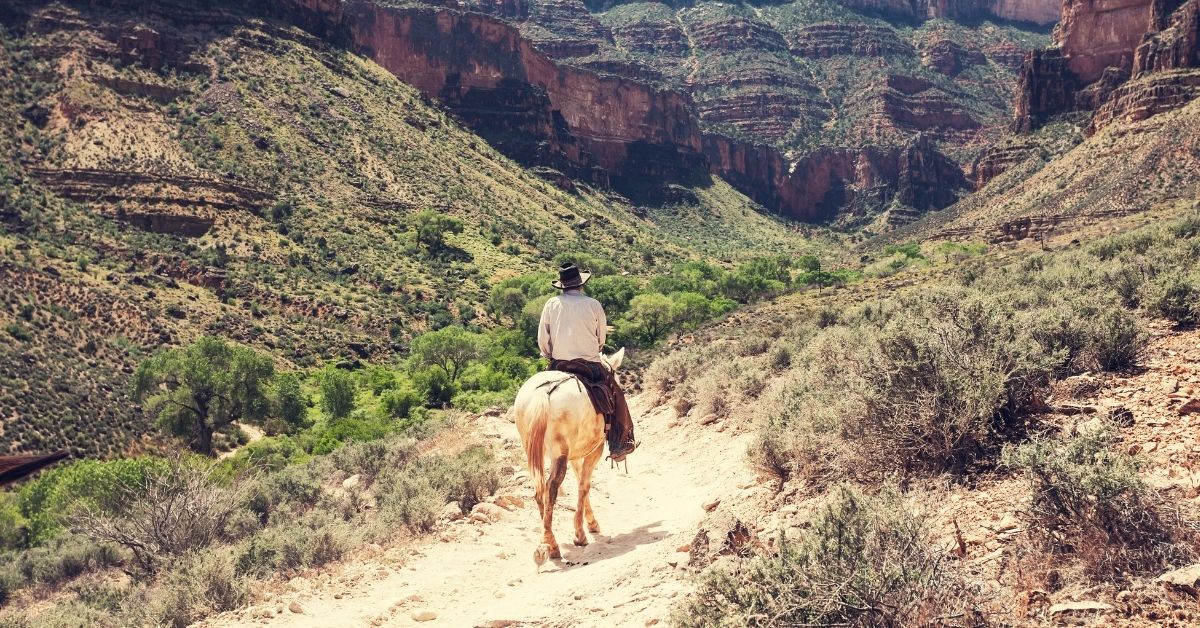
Weather Conditions
The weather can also play a role in how far your horse can travel. If it’s scorching hot outside, your horse will get tired much faster. That’s because they’ll work harder to stay cool and lose more water through sweating.
If it’s cold out, your horse might have a harder time getting warmed up. As a result, your horse will need to spend more energy to maintain its body temperature.
Be aware of potential weather conditions that might make travel more difficult. For example, high winds or heavy rain can make travel challenging (and even dangerous).
If the weather is bad, it’s best to wait it out or find shelter. Avoid pushing forward and risk getting stranded or lost.
Horse’s Health and Fitness
If you’re going to ride your horse all day long, make sure they’re in good health and condition for the journey. A horse that’s not used to being ridden for long periods will get tired much faster than a horse that’s used to it.
That’s why it’s important to increase the amount of time you spend riding each day. But, if you try to do too much too soon, you might end up overworking your horse. As a result, you could end up with an injured or sick animal.
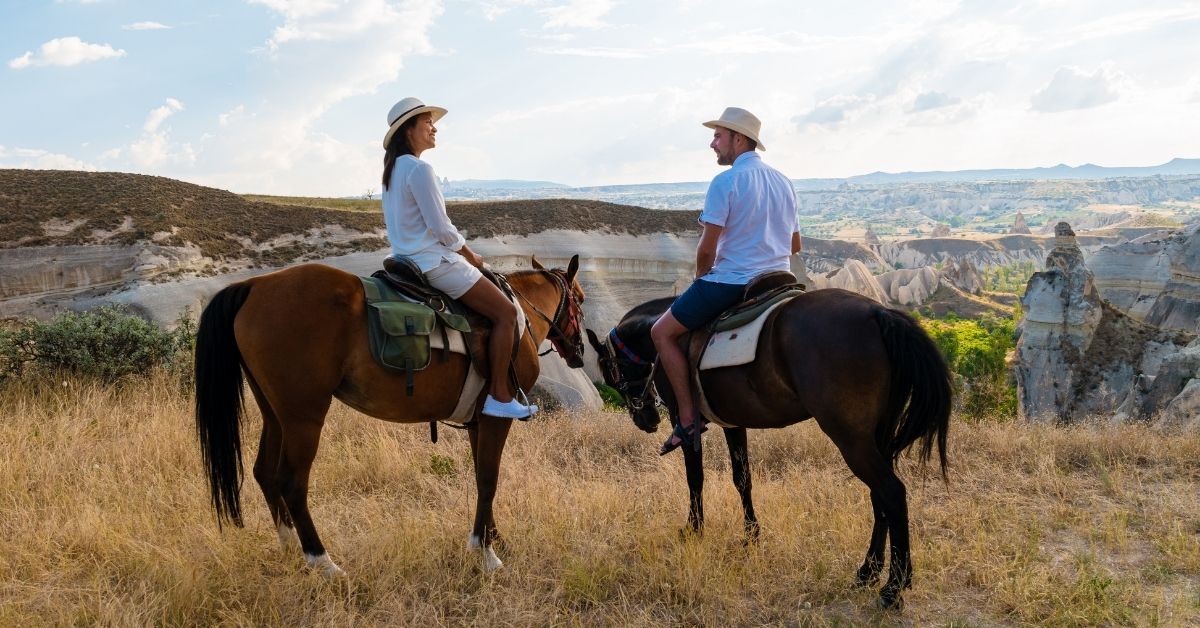
Proper Equipment for the Horse
There’s also the matter of having the right equipment for your horse. If you’re carrying a lot of gear, you might need to get a pack-saddle or panniers to help distribute the weight. Otherwise, your horse could end up with sore muscles or back problems.
Ensure that your saddle fits properly and isn’t causing any discomfort for your horse. For example, an ill-fitting saddle can rub and chafe the skin, which can be painful and lead to saddle sores.
It’s also important to have the right footwear for your horse. If you’re riding on rough terrain, you might need hoof boots to protect your feet. Otherwise, they could end up with painful cracks or chips in their hooves.
Conditioning for a Riding Discipline
If you’re planning on doing a lot of long-distance riding, it’s important to ensure that you and your horse are ready for it.
Spend some time conditioning your horse to ensure it can handle the demands of long-distance or prolonged riding. This can include working on their endurance by doing things like trail riding or trailering.
You should also ensure that you’re in good shape before you embark on a long journey. After all, you’re going to be spending a lot of time in the saddle, so you need to be able to handle it. That means being physically fit and having a good level of endurance.
Feed and Water
Finally, make sure you have an ample supply of food and water for your horse. If you’re going to be riding all day, you must ensure that your horse has enough to eat and drink.
You should bring along hay or grain and water buckets and regularly stop to let your horse rest. You can also consider stopping by natural food and water sources to let your horse drink and cool off. It’s a great option to travel as lightly as possible.
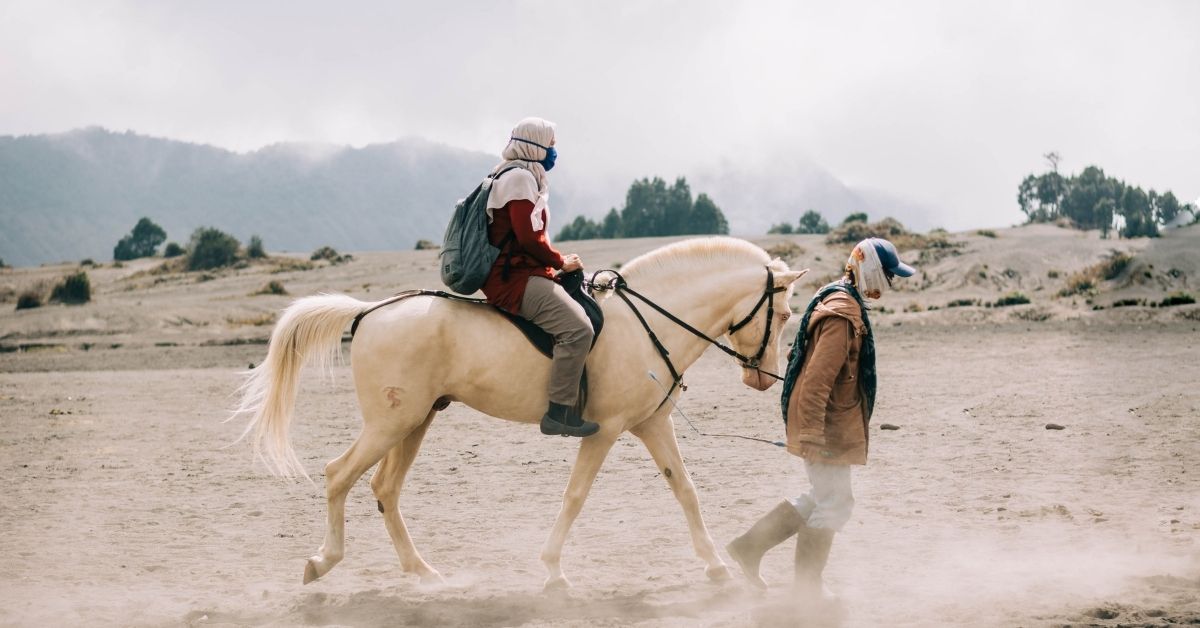
Best Endurance Horse Breeds
Different horse breeds specialize in different things. Some are better at sprinting, while others have more endurance. If you’re looking for a horse that can fulfill the latter, I’ve listed the top four best breeds for the job:
Arabian Horse
When it comes to endurance, the Arabian horse is king. These horses are known for their stamina and have been used in long-distance travel for centuries. They’re also relatively small, which makes them easier to transport when needed.
Arabian horses are also known for their intelligence, which can be helpful when spending long hours in the saddle. They’re also relatively easy to train, which is another bonus.
Mustang Horse
Mustang horses are more than just beauty — they’re also incredibly hardy. These horses are also known for their endurance and ability to survive in harsh conditions.
Mustang horses were originally bred in the American West and have been used by cowboys and ranchers for centuries. They’re also one of the most popular horse breeds for long-distance riders.
Morgan Horse
The Morgan horse is another solid choice for endurance riding. These horses are known for their versatility, strength, and stamina.
They were originally bred in Vermont and used for various tasks, including farming, logging, and even racing. Today, they’re still used for various disciplines and make great all-around horses.
The versatility of the Morgan horse means that it can be used for various riding styles. If you’re looking for a horse that can do it all—including one that can travel long distances—then the Morgan horse is a great option.
Anglo-Arabian Horse
Any breed that mixes with the Arabian will be a good choice for endurance riding. After all, the Arabian horse is known for dominating the endurance racing sport.
However, I’d like to put the Anglo-Arabian in its own category. These horses are a mix of Arabian and Thoroughbred horses, which makes for a perfect combination of speed and stamina.
The Anglo-Arabian Horses have the physical features of a Thoroughbred. At the same time, it will also have the elegance and high endurance of the Arabian.
With both genes, the Anglo-Arabian horse benefits in both facets.
Frequently Asked Questions
Got some more things in mind? I get it—traveling with a horse can be daunting. So, to help put your mind at ease, I’ve answered some frequently asked questions about long-distance riding below.
How Far Can a Horse-Drawn Carriage Travel in One Day?
According to research, a horse-drawn wagon or carriage can travel between 10 to 30 miles (16 to 48 kilometers) daily. However, this will depend on the terrain, the load’s weight, and the horse’s condition.
If you want to ensure your horse-drawn carriage lasts the entire period, it’s important to take breaks and let the horse rest. You should also have enough nourishment to keep your horse going despite the circumstances.
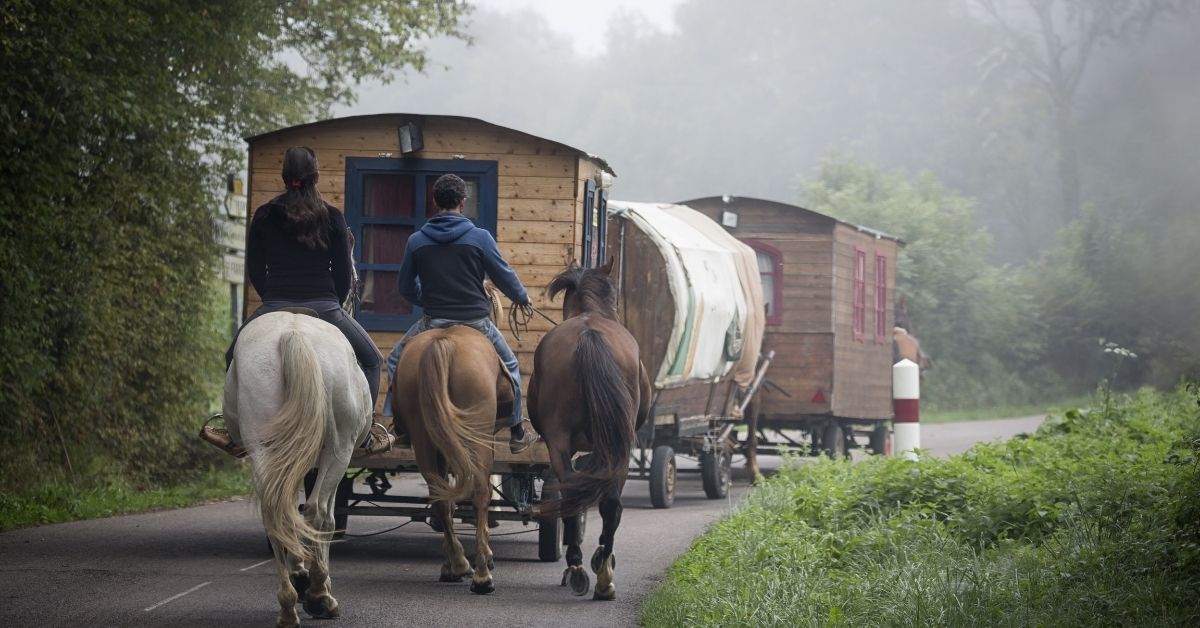
How Far Can Horses Travel in One Day with a Rider?
Horses tend to run efficiently on their own for longer distances and periods. On average, a horse can travel up to 50-plus miles in one day.
However, the distance will be significantly less when you factor in a rider. Generally, a horse can only travel 25 to 35 miles (40 to 56.5 kilometers) with a rider on its back.
Other factors that can affect the distance include the weight of the rider, the terrain, and the horse’s condition. So, if you think you and your horse can handle it, go for it!
How Far Can a Horse Jump?
Horses are capable of jumping impressive heights and distances, and their jumping ability can vary depending on their breed, size, and training.
In general, a horse can jump up to around 5 feet (1.5 meters) high and 15 feet (4.5 meters) long. However, some horses are able to jump even higher and farther, with some show jumpers and eventers regularly clearing heights of up to 6 feet (1.8 meters) and distances of up to 20 feet (6 meters) or more.
It’s important to note that not all horses are able to jump to these heights and distances, and it takes a lot of training and conditioning to build a horse’s jumping ability.
Jumping also puts a lot of strain on a horse’s legs and body, so it’s important to make sure that a horse is properly trained and conditioned before attempting to jump high or far.
How Far Can a Horse Swim?
Horses are not only expert jumpers but strong swimmers as well. They can swim for long periods and cover a lot of distances.
A horse can swim for approximately 30 minutes until it suffers from exhaustion. However, a physically fit and in excellent health horse can swim for an extensive period of time.
On average, horses can swim for approximately one mile before taking a break. It’s important to note that the distance will depend on the current, the water’s temperature, and the horse’s condition.
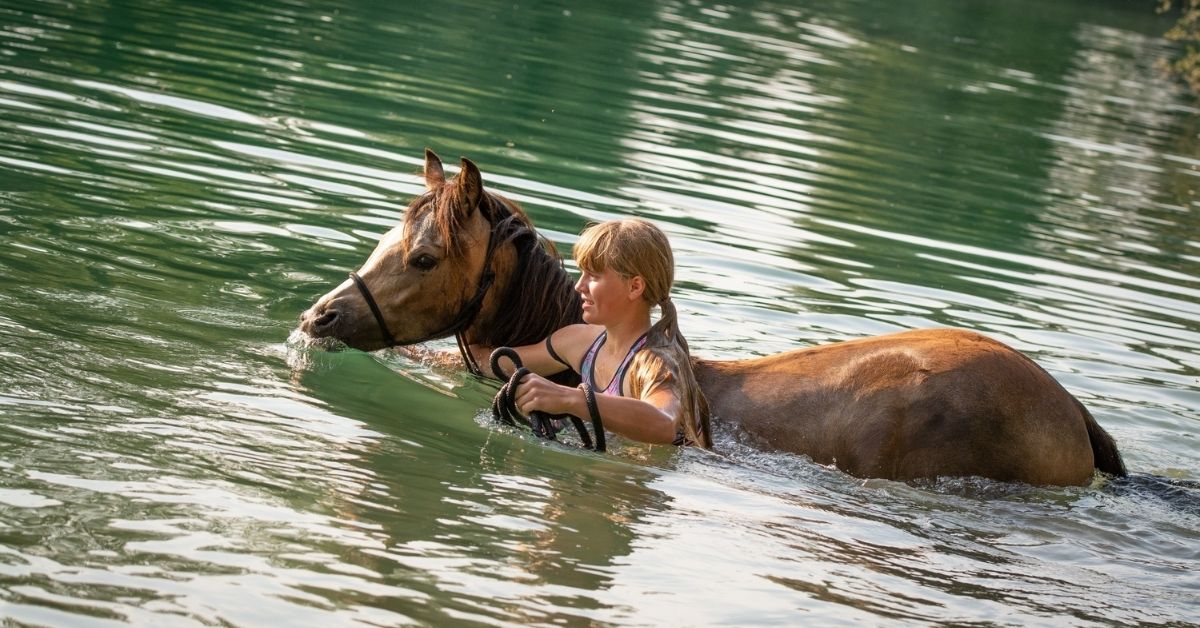
How Far Can a Horse See?
Horses have significant eyesight and can see for long distances. On average, a horse’s range of vision is approximately 300 degrees, much wider than a human’s 180-degree field of vision.
This level of vision allows horses to see up to 30 feet away. In addition, horses can see in color and have a better sense of night vision than humans.
Also, horses can see in low-light conditions and have excellent night vision. In fact, horses can see six times better than humans in low-light conditions and three times better in complete darkness.
Final Thoughts
There’s no doubt that horses are amazing creatures. Not only can they travel long distances, but they can also swim and jump to great heights.
It’s no wonder why horses have been used for transportation and travel for centuries. They’re pretty efficient when it comes to covering a lot of ground!
I hope this article answers your question and sheds some light on how far horses can travel in a day.
Leave a Comment Cancel reply
Save my name, email, and website in this browser for the next time I comment.

How Far Can Horses Travel In A Day?

A horse can typically travel between 20 to 30 miles in a day depending on various factors; however, a fit and well-conditioned horse can travel up to 50 miles if necessary.
Key takeaways
- Equine endurance varies based on the horse’s health, breed, and conditioning.
- Terrain and weather heavily influence how far a horse can travel in a day.
- Pace and load carried by the horse are crucial factors in determining daily travel distance.
- Frequent breaks and proper hydration and nutrition boost a horse’s travel capacity.
- Training and conditioning play a significant role in enhancing a horse’s endurance for longer journeys.
Understanding Equine Endurance: Factors Affecting Daily Travel Distance

When thinking about how far a horse can travel, equine endurance is a crucial concept. These magnificent animals vary in their travel distance , which can span quite a broad range from 10 to an impressive 100 miles in a day. The most common distance a healthy horse comfortably covers averages between 25 to 40 miles daily. Now, this isn’t just a matter of putting one hoof in front of another; several factors are at play.
A horse’s age is a determinant, with younger and middle-aged horses generally having better endurance. It’s not just the years lived but also the breed that matters. Some breeds are naturally more suited to long distances, boasting greater stamina. Alongside breed, a horse’s health cannot be overlooked – a healthy horse can outpace others by miles, literally. Then there’s the aspect of fitness level . Just like us, a horse in peak condition will be able to cover more ground.
But let’s talk about the champions of distance: endurance horses . These horses, through meticulous training and exceptional breeding, are the marathon runners of the equine world, capable of traveling up to 100 miles a day for consecutive days in competitions.
- Travel distance can range from 10 to 100 miles in a single day.
- The average daily distance for most horses is 25-40 miles .
- Equine endurance is influenced by the horse’s age, with mature yet not elderly horses showing greater stamina.
- A horse’s breed is closely linked to its potential for covering long distances.
- Health and fitness level are paramount for maximizing a horse’s travel ability.
- Specialized endurance horses are in a league of their own, capable of covering up to 100 miles daily over several days.
Key Elements Influencing a Horse’s Travel Capacity

Every horse has its unique travel capacity , and various elements can significantly affect how far and fast a horse can go. The horse’s gait sets the foundation for its traveling capabilities – a smooth, efficient gait means less energy spent and more ground covered. The terrain is also a major player; a flat pasture is far less taxing than mountainous trails.
Another factor that cannot be ignored is weather . Extreme heat or cold can take a toll on a horse’s endurance, as can windy or rainy conditions. Providing adequate rest periods is essential for preventing fatigue, while proper nutrition fuels the journey, ensuring that the horse has enough energy reserves.
Furthermore, the way a horse is equipped has its role. Comfortable and appropriate tack and equipment prevent injuries and allow freedom of movement. The rider’s skill remains pivotal; an experienced rider knows how to manage a horse’s pace and energy. Lastly, a well-executed horse conditioning program is imperative to build up stamina and endurance over time.
- The horse’s gait efficiency is fundamental in how much energy is conserved during travel.
- Terrain plays a significant role, as rough landscapes can decrease a horse’s travel capacity.
- Weather conditions impact a horse’s ability to maintain its endurance and speed.
- Ensuring regular rest periods and sufficient nutrition are key to sustain long travels.
- Proper tack and equipment are crucial for both the horse’s comfort and travel capacity.
- The rider’s skill in navigating and pacing directly affects how far a horse can travel.
- Horse conditioning routines prepare and enhance a horse’s natural endurance for longer distances.
Related Posts:

Didn't find what you need? Use the search!
Pet Keen is reader-supported. When you buy via links on our site, we may earn an affiliate commission at no cost to you. Learn more .
How Far Can a Horse Travel in a Day? The Interesting Answer
Have you ever wondered how far can a horse travel in a day? Many factors will determine the final figure, including the horse’s size, breed, and age. The location and therefore, the environmental and physical demands of the area also play a massive part in determining how far a horse can travel, as well as if the horse is carrying a rider or pulling a load.
It can be a difficult question to answer, but if you’re planning a day on the trail, intend to compete with your horse, or are trekking on any journey and want to be sure you can cover the distance, it is useful to know how far a horse can travel in one day.
On average, a horse can be ridden between 25 and 35 miles in a day, with the typical distance being closer to the bottom of this range.
- Today’s Horses
It is worth bearing in mind that the way that we use horses today is different from how we used them hundreds of years ago. We have cars and other vehicles that will carry us and our goods over long distances.
This means we no longer rely on horses to make long and arduous journeys every single day. As such, while horses were once trained and conditioned to complete exceptional treks and journeys every single day, they are less capable of doing so today. There are a few exceptions, however, and you can see them in endurance races.
While today’s horse will travel around 25 miles, the horse of yesteryear would have been better able to travel 35 miles.
- One-Off vs. Daily Commute
A horse might be able to complete a 30-mile journey today but will require one or several days to recover from this feat. If you want to travel hundreds of miles over several days, you would be better off asking your horse to complete around 15 miles each day. This will also be easier on you, your back, and the rest of your body.
- Athletic Conditioning
The more often a horse completes a long journey, the better equipped they will be to do it again. Horses can benefit from athletic conditioning in the same way that people can. This is especially true of endurance and competitive horses . Follow a professional training schedule, and you can greatly improve the distance that your horse can travel.
An endurance race can last 24 to 30 hours and cover between 50 and 200 miles in total, but these are extreme distances that are comparable to an ultra-marathon runner completing a 100-mile run.
Most horses prefer moderate ground under their feet—nothing too wet and boggy or too dry and hard. This enables them to keep going, and it will prevent their muscles from getting sore and injuries from occurring. Anything other than these optimal conditions means your horse will cover less ground.
Besides ground conditions, horses prefer certain weather conditions. Like humans, they will become exhausted more quickly in the hot sun, though some horses that have been bred in these conditions may prefer hot conditions to cold, wet, and windy ones.
Ill-fitting saddles or an ill-fitting bridle can cause discomfort and pain to your horse. This will mean your ride cannot cover the same distance that they might otherwise would have. Losing a shoe will inevitably mean your day’s riding is over, and it could greatly reduce the distance that you cover. Ensure that your horse’s equipment is properly maintained to minimize the risk of injury and the likelihood of having to cut your day short.
- Rider Hardiness
While the athleticism, strength, and endurance of your horse are obviously important in determining the daily distance that they can cover, so too is your own hardiness. Riding a horse for 6 hours at once is painful and tiring, and even experienced riders struggle to stay in the saddle for an entire day. While your horse might be able to cover 30 miles, you might have to call it after 10.
Taking all these factors into account, it is fair to say that the average horse and rider can travel between 15 and 20 miles a day. It is exceptional and rare for one to be able to cover more than 30 miles in 24 hours, and even this length of journey would be a one-off trip, requiring several days’ rest afterward, and they would need to be in perfect weather and geographical conditions. Also, you and your horse would need to be conditioned for the journey and have the proper equipment.
Related Horse Reads:
- 6 Beautiful Horse Mane Styles You Can Do Yourself (With Pictures)
- 10 Most Exotic Horse Breeds (With Pictures)
- 5 DIY Horse Jumps You Can Build Today (With Pictures)
Featured Image Credit: Pixabay
Oliver Jones
Oliver (Ollie) Jones - A zoologist and freelance writer living in South Australia with his partner Alex, their dog Pepper, and their cat Steve (who declined to be pictured). Ollie, originally from the USA, holds his master's degree in wildlife biology and moved to Australia to pursue his career and passion but has found a new love for working online and writing about animals of all types.
Related articles
11 diy horse stall plans you can make today (with pictures), how old should a horse be before riding facts & tips, how to teach a horse to lay down in 5 simple steps, how long are horses pregnant (gestation period) vet reviewed science & facts.
Search our database of over 16753 posts with up-to-date information from our experts and veterinarians.
Want to talk to a vet online?
Whether you have concerns about your dog, cat, or other pet, trained vets have the answers!

Welcome to Savvy Horsewoman
Posts may contain affiliate links and/or sponsored products. See the Disclosure.
How Far Can a Horse Travel in a Day
Wild horses now vs. in the past.
Horses are used much differently today than what they were used for in the past, regardless of if they are domesticated or wild. Because of today’s changes in technology and transportation, horses are no longer needed to pull wagons or ride like they were during pioneering journeys. The distance a horse is able to travel is largely dependent on its endurance , and since they are not used as frequently for endurance-heavy activities nowadays as they once were, their ability to travel greater distances has been impacted. Horses in the past used to frequently travel up to 35 miles per day, but now they are rarely able to go more than 25 miles in one day. It is important to note, however, that a horse kept in good shape can travel up to 50 miles in a day.

How Horses Are Built
As a flight animal, a horse will gallop or canter away for a short distance from danger. When they need to get out of immediate danger, horses will trot longer distances. The average horse cannot gallop for more than a couple miles before getting tired. This is why they may gallop to get away from immediate danger, but will switch to a slower gait (such as a trot or canter) when traveling longer distances. Historically, the Pony Express horses were only able to travel about 10-15 miles at a canter or trot before a rider would stop to switch to a “fresh” horse.
How Far Can A Horse Travel In A Day
There are many factors that go into how far a horse can travel in a single day. Some of the main factors are how fit your horse is, their skills, and how well you take care of your horse. Other factors are what equipment is used on the horse and the severity of the weather and terrain. Having proper rest, plenty of clean water, and being well-fed is going to greatly help the distance in which your horse can travel in a day.
How Far Can a Horse Travel at Each Gait?
How many miles per day a horse can travel depends on the gait at which it is traveling, as well as the terrain that they are covering the distance over. At a steady walking pace, a horse can travel 25 to 35 miles per day. When traveling at a trot, a horse can go about twenty miles. A cantering horse moves at about 10-17 miles per hour, which means a very fit horse can travel about seven miles; however, the more average horse will not be able to travel nearly as far. Finally, when galloping, the average horse cannot travel more than two miles before becoming fatigued.
How Fast Can a Horse Travel at Each Gait ?
There are four gaits at which a horse can travel. A walking horse is moving about 4 miles per hour. When urged to a trot, a horse’s speed goes up to about 8 to 12 miles per hour. The next gait is a canter, where horses are clocked at going anywhere from 10 to 17 miles per hour. The fastest gait, called a gallop, is where a horse travels 25 to 30 miles per hour.
How a Horse’s Health and Fitness Impacts Distance
A horse’s overall health and fitness impacts just how much distance in a given day it can cover without an issue. Typically, your more endurance-trained horses can cover up to 100 miles per day. An average trail horse can cover upwards of 50 miles within a day. Mostly, either type of horse can not go more than a few consecutive days at this distance without a few days of rest and recovery in between.
How Weather and Terrain Impact Distance
Depending on the terrain and weather, horses will not cover the same distance over tougher terrain than smooth terrain. Unknown terrains, like rocky areas and hills and mountains, will naturally slow a horse down as they carefully navigate through them. These tough terrains also put more strain on a horse’s cardiovascular system.
Going over various types of terrain will also put different types of loads on the horse’s joints and hooves. Avoid injuries by taking things slow, which will increase the overall travel time. Hoof protection is an option for those wanting to give their horse’s a bit of a barrier between their hooves and the terrain in which they will be covering.
When the weather is a concerning factor, make sure to keep an eye on it where you are and where you will be traveling. Do not go out in extreme hot or extreme cold weather. Most horses are able to travel the best at the optimal temperatures of 70 to 90 degrees Farenheit (21 to 32 degrees Celsius). With rain, no horse or rider particularly wants to be out riding, especially since rain can cause the ground to become muddy and make it difficult for the horse to safely move. After a few short miles, try to find shelter to wait out the storm.
Extreme weather can cause injury and illness in horses. In too hot of weather, horses can lose electrolytes through sweat, even if there is low humidity that causes the sweat to quickly evaporate. On the other side of the spectrum, too cold weather can cause muscles to freeze or tense up, and the hard ground can negatively impact a horse’s hooves and joints.

Feed, Water, And Rest The Horse
Sufficient rest, water, and food will allow a horse to recover from a trip faster. Allowing your horse to rest and have access to clean water throughout the trail will ensure a better journey overall, as this will help it be able to safely travel longer distances. It is a good idea to check ahead of time and make sure there is plenty of water along the route which you plan to ride your horse when traveling longer distances.
Tack & Equipment
As with any riding, proper fitting tack is essential. Equipment that is ill-fitting can and will influence the distance of travel you do in a day. One precautionary step that you can also take is making sure that your horse’s shoes are not at the end of a cycle, as well as that the nails are not loose. Keeping a hoof boot or two in a saddle bag in case of emergency will be a savior in case a shoe comes off mid-journey.
Rider’s Skills And Fitness
As a rider, do not overdo a journey or long trip that is out of your capability. To check your own personal stamina over distance, take multiple shorter-mile trips prior to the long trip. If your riding skills are not able to maneuver through tough terrains, such as rocky areas, puddles, and rivers, it would be best to plan a different route. You do not want to end up stuck in the middle of nowhere!
How to Condition Your Horse for Long-Distance Travel
Conditioning your horse for long-distance travel is similar to that of a marathon runner. You wouldn’t take your horse out and ride as far and long as possible on the first day. Building up both fitness and stamina by starting out with shorter, small day-trail outings is essential to keeping your horse healthy while preparing it to travel long distances. As you and the horse get fitter and are able to more easily travel the shorter, smaller distances, you can gradually increase the mileage.
Gradually increasing travel distances is not the only way to condition your horse for long journies. Riding over various terrains will also help both you and your horse learn how to navigate a long ride. Not only does it allow the horse to adjust to carrying its weight differently over the various terrains, but you will also become aware of how the horse feels when it adjusts itself.

How fast can a horse run?
A horse can run 25 to 30 miles per hour at a gallop.
What is the fastest a horse traveled 100 miles?
The fastest 100-mile record is an endurance horse that covered the distance in 5 hours, 45 minutes, and 44 seconds.
How many miles can a horse travel in an hour?
How many miles a horse can travel in an hour is dependent on its gait.
How far can a mule travel in a day?
Mules can travel up to 20 miles a day. They typically have more stamina than a horse, and also tend to be steadier over rougher terrain due to the fact that they can see where they put their hind feet , which a horse cannot do.
How far can a horse gallop?
On average, a horse can not travel more than 2 miles at a gallop before becoming fatigued.
How far can a horse trot?
A horse can continuously trot 20 miles.
How long would it take a horse to travel 100 miles?
Unless you are on a fit endurance equine athlete, most trail horses in good shape can cover 50 miles in a day.
How far can a horse travel in 5 days?
If on average a horse can travel 25 – 50 miles a day, in five days a horse can travel 125 – 250 miles.
How far can a horse travel in 8 hours?
At a comfortable walking pace, a horse can travel 32 miles in 8 hours.
You may also enjoy:
How to recognise laminitis in your horse, buying a horse read this first, how to ride a horse without a …, how to perform routine health checks on …, leave a comment cancel reply.
This site uses Akismet to reduce spam. Learn how your comment data is processed .

How Far can a Horse Travel in a Day
Last updated on March 11th, 2023 at 10:19 pm
How Far Can a Horse Travel in a Day?
A horse can travel roughly 160 kilometres (100 Miles) in a single day if it’s in amazingly good shape with strong endurance. On the other hand, an ordinary trail horse (healthy horse) can travel about half of that, 80 kilometres (50 Miles) at a brisk walking pace with a couple of water breaks and reasonable time to cool down.
Just like humans, how far an average horse can travel in a single day depends on its fitness level. Someone who’s unfit and out of shape isn’t going to be able to walk 30 kilometres in a day. The same can be said for a typical horse.
But there are other factors at play for how far a horse can go. For example, any horse should be able to travel for thousands of kilometres if the parameters are agreeable. The horse must be trained for such a journey, it can’t be pushed too hard, and it needs to be properly equipped, and you need to keep the horse healthy.
One of the most famous horse journeys across North America was when someone named Nan J. Aspinwall road from San Francisco to New York on the back of his horse, covering a total of 178 days and over 5000 kilometres.
How far a horse can travel in one day depends on how long they are travelling. For example, a horse and rider travelling for weeks can usually go as far as about 50 kilometres (30 Miles) a day. On the other hand, a horse and rider travelling for only a single day can go double that, up to 100 kilometres (60 Miles).
The big difference here is that the day after riding for 100 kilometres, the horse is probably not going to be able to repeat the same distance. It will need rest for a day or two. This is why on longer journeys, the distance a horse can travel per day is cut in half.
How Far Can a Horse Travel in 8 Hours?
Just about any horse can walk comfortably for a full 8 hours. During this time, a horse will typically cover about 50 kilometres. It will honestly be more difficult for a human to stay in the saddle for a full 8 hours than for the horse to keep walking.
If the horse trots or canters for part of the journey, it will gain a few extra kilometres by the end of the 8-hour day. But a lot of it depends on the terrain as well. Going up and down hills will be very taxing for a horse’s limbs and their cardiovascular system. Rocky or hard terrain will also hurt a horse’s hooves and give them sore joints.
If a horse must travel across treacherous terrain, it won’t make it nearly as far in eight hours as it normally would. It’s the same as if you were to walk all day uphill as opposed to walking along a flat trail.
Another thing that can determine how far a horse travels in eight hours is the weather. Weather conditions must be taken into account when planning any ride. A horse will lose quite a bit of body water and electrolytes when they sweat. If your horse gets dehydrated in hot weather, it won’t be able to keep going for long.
If the weather is hot or humid, plan to stop frequently. Replenish your horse’s electrolytes as quickly as possible and keep your eyes open for when your horse starts to sweat. Sometimes it’s difficult to tell because wind will evaporate sweat quickly.
And of course, things like snow and rain will also slow down a horse significantly.
How Far Can a Horse Run Without Stopping?
A horse can run at its fastest pace , what is known as a gallop, without stopping for just over 3 kilometres. After 3 kilometers, fatigue will begin to set in. At an outright gallop, just about any horse will be toast after 3 kilometers. An outright gallop is usually between 70 and 80 kilometers per hour.
However, if the horse is running at a reasonable pace, such as a trot, it can probably go for at least 35 kilometers before it needs to stop and take a break. Remember that horses are not machines. They don’t have endless supplies of energy to keep running forever. They get tired just like any other animal.
It’s also important to know that we’re talking about average horses. A horse that has been trained for long distance running can go significantly farther without needing to take a break. Still, no horse should be run longer than they can stand it, otherwise they can suffer from injuries. Ahorse can run harder and longer when they are properly hydrated and have been given lots of rest.
Can A Human Outrun a Horse?
A human cannot outrun a horse in a sprint. It’s just not going to happen. Most humans couldn’t even beat an ostrich in a footrace. We are not the fastest animals in the world. For example, let’s take a look at a horse’s top speed vs a human’s top speed.
The world record for horse speed is 70.8 kilometers per hour. Usain Bolt holds the record for the fastest human speed at 43.4 kilometers per hour. There is a very clear winner here. A human could never outrun a horse. At least, not in the 100-meter dash.
But a human could easily outrun a horse in a marathon. In fact, humans can outrun any terrestrial animal on Earth when it comes to endurance running. This is because humans have up to 4 million sweat glands on our body that allow us to cool ourselves while we run. We also don’t have fur, enabling us to regulate our temperature much better. Unlike dogs, we don’t have to cool down by panting with our tongues hanging out.
Horses are faster than humans. But if a person were well trained, they could run without stopping for much longer than a horse, easily beating one in a marathon.
How Far Can Horses Travel FAQ
A typical average horse can easily walk for 8 hours a day. They should have some breaks and will need water depending on the temperature and the if it is a fit horse. Trained horses can travel further and faster than non-trained horses but you still need to take various factors into account. You need to pay attention to the horse’s legs, the windy weather, the horse’s physical condition, any steep hills, any deep mud and any saddle sores from the long rides.
Long distances are going to take more time, and typically require more out of your horse. A long ride will also require you to be able to endure sitting on the horse for a long period of time. The horse’s physical health, the horse’s breed and proper nutrition all play a part in the journey or long trail ride.
What are the Best Horse Breeds For Long Distances?
Arabian horses are known for their endurance and endurance racing. The American quarter horse is also well known for its all-day attitude and ability to travel long distances. Trail riding, and long horseback rides are common for these types of horses. Trail riding is also something that other breeds can do as well, like the thoroughbred, the Friesian , the warmblood, and even bigger draft horses. You just need to make sure you have the necessary riding equipment, stay at a slower pace and enjoy an average speed. Older horses can also benefit from the fitness required for longer trail rides, they may not be up for an intense ride, but they will still benefit from the fitness.
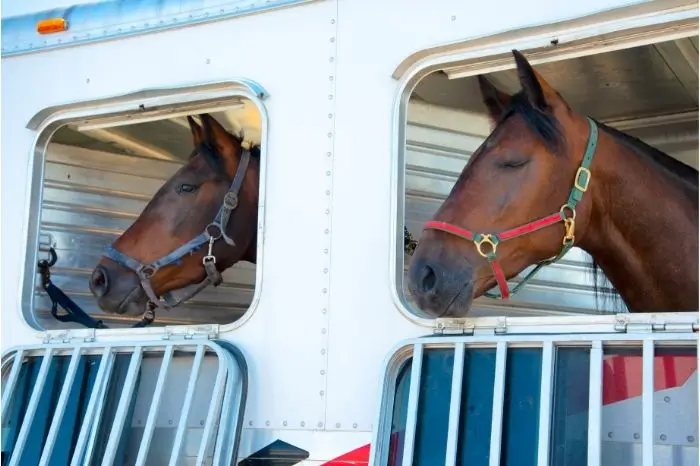
How Many Miles Can A Horse Travel In One Day?
Last Updated on April 26, 2022 by Fabiola L.
The question, “How many miles can a horse travel in one day?” can be answered by calculating the horse’s average speed while traveling. But is that answer correct? This article looks at three other methods for calculating how many miles a horse can travel in one day, including a method based on the horse’s daily distance, the horse’s total distance, and the horse’s average speed.
Table of Contents
What Is The Maximum Distance A Horse Can Travel In One Day?
The maximum distance a horse can travel in one day depends on the length of its stride, the size of the horse, and the ground conditions. Horses typically cover up to 15 miles a day on dry, hard dirt with no obstacles. But if they’re properly trained, horses can cover up to 25 miles a day. But if it’s too hard, horses can get tired and have trouble covering that distance.
What Are Some Other Factors That Might Affect The Horse’s Performance?
If you think about it, you’d probably agree that horses are very sensitive to their environment. Just as people are sensitive to the weather, they are sensitive to their surroundings. You can’t just go riding in the country and expect things to be okay. You need to consider all the possible factors before you head out into the pasture. It is important to keep track of the weather and the seasons to maintain your horse’s health and safety.
You need to understand what changes the weather brings about to be able to deal with them appropriately. Horses are much more sensitive than us to changes in the weather. For example, a change in the weather can be dangerous for a horse. They can get sick. A change in the temperature can affect their coat, and that can make it difficult for them to keep warm. A change in the rain can wash away their feed and make it more difficult for them to eat. In addition, you need to be aware of the types of activities that your horse engages in.
You need to know whether your horse is active or inactive. You can check your horse’s activity level by taking note of how much time your horse spends working and how much time he spends resting.
Why Might A Horse B e Tired?
There are three possible reasons why a horse might be tired, according to experts. One reason: The horse might have been running very hard in the race. Two: The horse might have been injured. Three: The horse might be suffering from mental fatigue . Mental fatigue can occur when people think about doing something for a long period without achieving anything.
Read more about How to Build a Better Topline on a Horse

How Can You Make Sure Your Horse Gets Plenty Of Exercises?
To keep a horse fit and healthy, make sure it gets at least 30 minutes of riding or exercise every day. Keep a daily journal of how much time your horse spends working in the paddock. A diary is a simple and inexpensive method of recording your horse’s daily activities and ensuring that he or she is getting enough time for exercise. A calendar can be another tool for keeping track of how much time your horse spends working. Both methods allow you to check up on your horse’s progress and ensure that you are meeting the minimum daily requirement.
What Is The Average Weight Of A Horse?
There are two types of weight that horses have: empty weight and full weight. Empty weight is the weight of a horse without all of its tack, food, bedding, and accessories. Full weight is the weight of a horse with all of its tack, food, bedding, and accessories. In the U.S., the empty weight of a horse is 456 pounds, and the full weight is 523 pounds.
How Can You Make Your Horse Stay In Shape?
How do you keep your horse in shape? There are several things that you can do to help your horse stay in shape. First, make sure that your horse gets plenty of exercise . Next, make sure that your horse is fed a healthy diet. Finally, make sure that your horse is getting proper medical attention. If your horse isn’t taking care of itself properly, it could end up getting injured or sick. So, if you have a horse that needs some extra help staying in shape, don’t hesitate to get him or her some veterinary attention.
Final Words On How Many Miles Can A Horse Travel In One Day?
In conclusion, the average horse will travel about 25 miles a day, which equates to around 7 miles per hour. The amount of mileage a horse will cover in a day will depend on several factors, including the breed, the individual horse, and the surface on which it is traveling. Horses also have different abilities, and some horses are better suited for carrying heavy loads than others. It is possible to accurately calculate how much mileage a horse will travel in a day based on the type of horse and its load.
How many hours a day can a horse be ridden?
We all know how much we need to sleep. It takes around seven hours for our bodies to recover from a night’s rest. But we also know that horses don’t need to sleep for days on end. The amount of time a horse can be ridden depends on several factors, including its size, breed, and age. Some breeds can be ridden longer than others; however, many limits must be met for any horse to be ridden for more than eight hours. The American Association of Equine Practitioners sets the maximum for riding at 20 hours.
What do horses do when they’re tired?
Horses don’t know they’re tired until they’re too tired to continue. The only way to find out if your horse is too tired is to ride him and see how he acts. Horses don’t just sit around looking sad because they’re tired. They are usually the happiest when they’re working hard and can’t wait to do it again. The secret is to not push your horse too hard. Let him have fun, but don’t let him overdo it. He’ll tell you if he’s ready for a break.
Do horse’s legs get tired?
The answer is no, according to the University of Guelph’s School of Agricultural Sciences, which studied a group of horses over five days. Researchers used GPS tracking and accelerometers to measure the horses’ movements and found that the animals spent up to 10 hours a day just walking. The study also found that the horses’ speed increased dramatically as they went through the night. According to the researchers, it could be that the horses get tired in the evening because their metabolism slows down and they need to slow down to rest.
How can I help my tired horse?
So you need to give your horse a break. After all, you’re giving them every chance possible to improve their performance. But you mustn’t let them rest on their laurels. After each ride, ensure that they’re getting fresh feed and clean water and that their tack is kept in top shape. When you come to visit, pay close attention to their feet, legs, and joints, and if they seem stiff, don’t hesitate to book them in for some chiropractic care. Make sure your horse is always up to date on vaccinations and that they’re being wormed regularly. All of these things will help keep your horse healthy and perform well.
Learn more about How Far Could A Horse Travel In A Day? – The Best 5 Horse Travel Tips

IMAGES
VIDEO
COMMENTS
However, an average, well-conditioned horse, with a skilled rider, can comfortably cover 20-30 miles in a day on flat terrain at a steady walk or trot. This number can vary if factors such as difficult terrain, adverse weather conditions, or health issues arise. Keep in mind that marathon and endurance races cater to the extremes, with some ...
A horse can go up to four miles per hour when it walks and typically travels somewhere between eight and 12 miles per hour at a trot. At a canter, a fit horse can speed up anywhere between 12 and 15 miles per hour. At a gallop, they can travel between 25 and 30 miles per hour on average. Of course, a gallop can't be sustained for very long ...
More than anything, she loves meeting horses and the people who love them and getting the chance to tell their stories through photographs! Horses can travel anywhere from 10 to 100 miles in a day, depending on their age, breed, health, and level of fitness. The average horse can travel 25-40 miles in a day, whereas endurance horses can travel ...
You can ride your horse 25 and 35 miles (40 - 56.5 km) without rest when it walks steady. An average trail horse in decent shape can withstand a journey of 50 miles (80.5 km) in one day, while a fit endurance competitor will be able to travel even 100 miles (161 km) in a day. On the other hand, most of them can't endure a few consecutive ...
How far can a horse travel in a day? Walking steadily, a horse can travel about 20 and 30 miles a day, with an average of 25 miles per day. You might think a galloping horse can travel more miles in a day, but a galloping horse needs to rest every 2.5 miles. A horse will cover more daily miles if kept at a walk or a trot than if ridden at a gallop.
Elite endurance horses can travel up to 100 miles in a day. However, an average horse in good health, given appropriate rest and water breaks, can manage around 50 miles. The capacity for a horse to travel long distances is not based on physical fitness alone but on a myriad of factors such as breed, age, and level of training.
One of the most impressive aspects of horseback riding is the distance that horses can travel in a single day. Depending on the terrain, horses can cover anywhere from 25 to 50 miles in a day. This is due to their impressive endurance and stamina, which allows them to maintain a steady pace for long periods of time.
A horse's ability to travel long distances in a single day is directly tied to its overall health and fitness. Horses that are well-trained for endurance can cover up to 100 miles per day, while an average trail horse can manage around 50 miles within a given day. However, it is important to note that these distances cannot be sustained over ...
Horses can travel many miles in the span of twenty-four hours. There is actually a competition that judges the horse on this called endurance riding. Endurance is a sport that judges the horse's stamina and ability to go up to 100 miles in the course of one day. The record time for a horse to do 100 miles in one sitting is 5 hours and 45 minutes. Average horses can go around 35 miles in one ...
Generally, a healthy and fit horse can travel up to 20 miles in one day. However, this distance can be increased if the horse is used to long-distance riding and is in peak physical condition. A horse that is trained for long-distance riding can travel up to 30 miles in a single day, while a horse that is used to carrying a rider and baggage ...
Horses can cover approximately 20 miles daily. However, there are horses that have covered over 100 miles in less than a day. While horses can travel 20 to 30 miles daily or more, it's not recommendable for their health in the long-term. This is evident with famous races in the past, like the 1892 race, where horses covered 350 miles in three ...
Horses can travel on average 30 to 50 miles a day if they are in good condition. However, top endurance horses can travel up to 100 miles in a day with a rider on their back. Factors that determine how far a horse can travel include terrain, weather conditions, fitness, health, and the horse's breed. Horses can only run at full speed for 2 to ...
One Day Trip vs. Consecutive Days Trip . Years ago, as well as today, riders needed to take into consideration how many days the trip would take. On average, a healthy horse can travel anywhere from 25 to 35 miles a day. This distance needs to be at a slower pace and with breaks for water.
Horses tend to run efficiently on their own for longer distances and periods. On average, a horse can travel up to 50-plus miles in one day. However, the distance will be significantly less when you factor in a rider. Generally, a horse can only travel 25 to 35 miles (40 to 56.5 kilometers) with a rider on its back.
Travel distance can range from 10 to 100 miles in a single day. The average daily distance for most horses is 25-40 miles. Equine endurance is influenced by the horse's age, with mature yet not elderly horses showing greater stamina. A horse's breed is closely linked to its potential for covering long distances.
Conclusion. Taking all these factors into account, it is fair to say that the average horse and rider can travel between 15 and 20 miles a day. It is exceptional and rare for one to be able to cover more than 30 miles in 24 hours, and even this length of journey would be a one-off trip, requiring several days' rest afterward, and they would ...
How many miles per day a horse can travel depends on the gait at which it is traveling, as well as the terrain that they are covering the distance over. At a steady walking pace, a horse can travel 25 to 35 miles per day. When traveling at a trot, a horse can go about twenty miles. A cantering horse moves at about 10-17 miles per hour, which ...
A horse can travel roughly 160 kilometres (100 Miles) in a single day if it's in amazingly good shape with strong endurance. On the other hand, an ordinary trail horse (healthy horse) can travel about half of that, 80 kilometres (50 Miles) at a brisk walking pace with a couple of water breaks and reasonable time to cool down.
An average horse covers a distance of approximately 25 to 35 miles in a day while traveling on horseback. However, this range may vary as it is influenced by several factors. The pace of the horse plays a significant role. On average, a horse can walk continuously for up to 8 hours, covering a distance of approximately 32 miles during that time ...
The maximum distance a horse can travel in one day depends on the length of its stride, the size of the horse, and the ground conditions. Horses typically cover up to 15 miles a day on dry, hard dirt with no obstacles. But if they're properly trained, horses can cover up to 25 miles a day.
Even then, a day's break or more is required. Some horses have been trained to cover 50-100 miles in one day. They would need rested after that day. I have been using 45 miles per day for a riding horse and my players have used it to their advantage with consecutive day usage.
The travel pace description and table on page 181-182 of the Player's Handbook states that a normal travel day may contain 8 hours, and gives the following table: Pace: /Hour /Day Miles in an 8-hour walking day: Fast 4 miles 30 miles --> 4x8 = 32 miles (-2 miles a day) Slow 2 miles 18 miles --> 2x8 = 16 miles (+2 miles a day) Why is there an ...
How far could a person expect to travel in a single day on horseback or in a stagecoach? ... Most people, with just the one horse, would be much slower. Coach travel was notoriously slow and unreliable since 'roads' were just dirt tracks that could often turn very muddy, until the arrival of decent turnpike and macadamised roads. ...